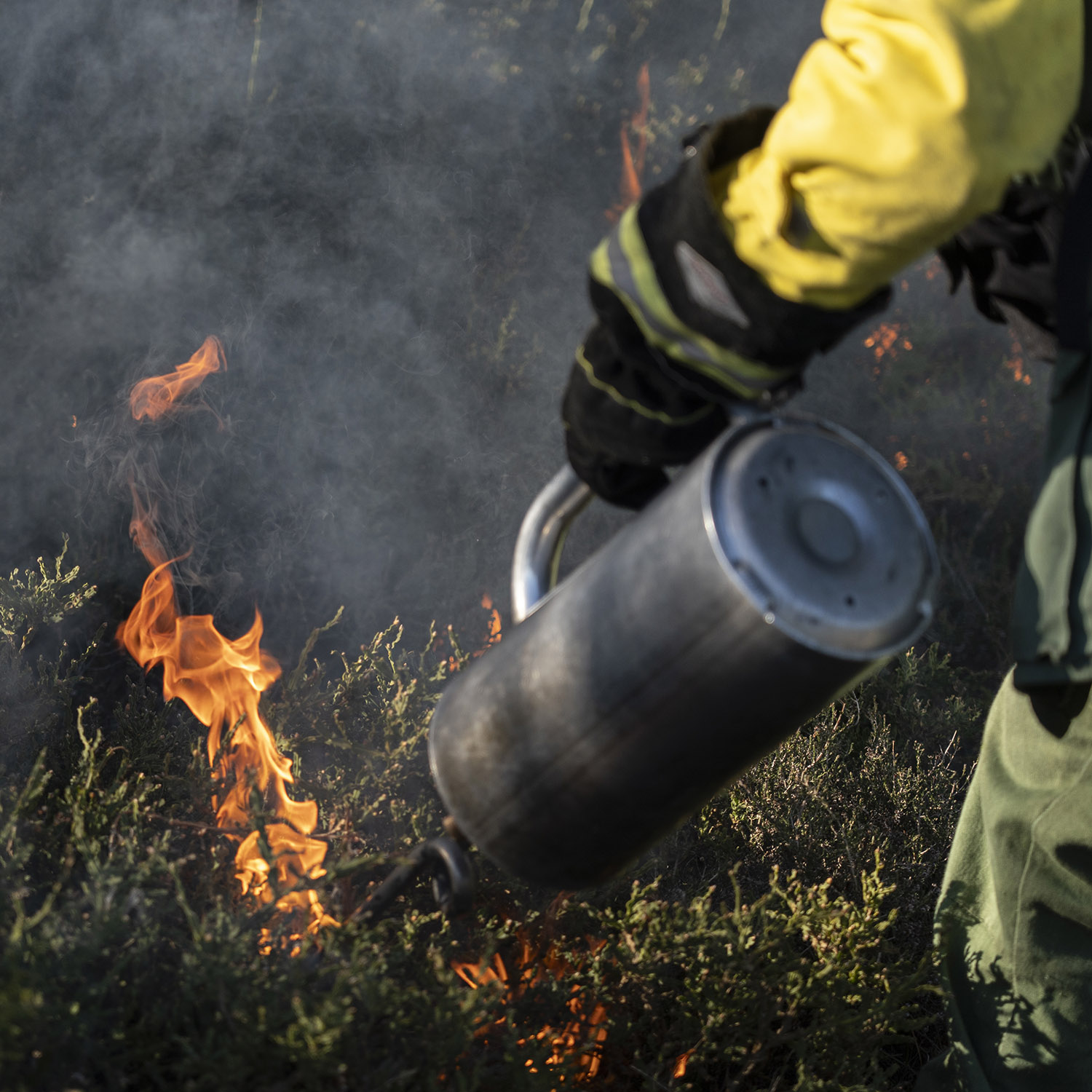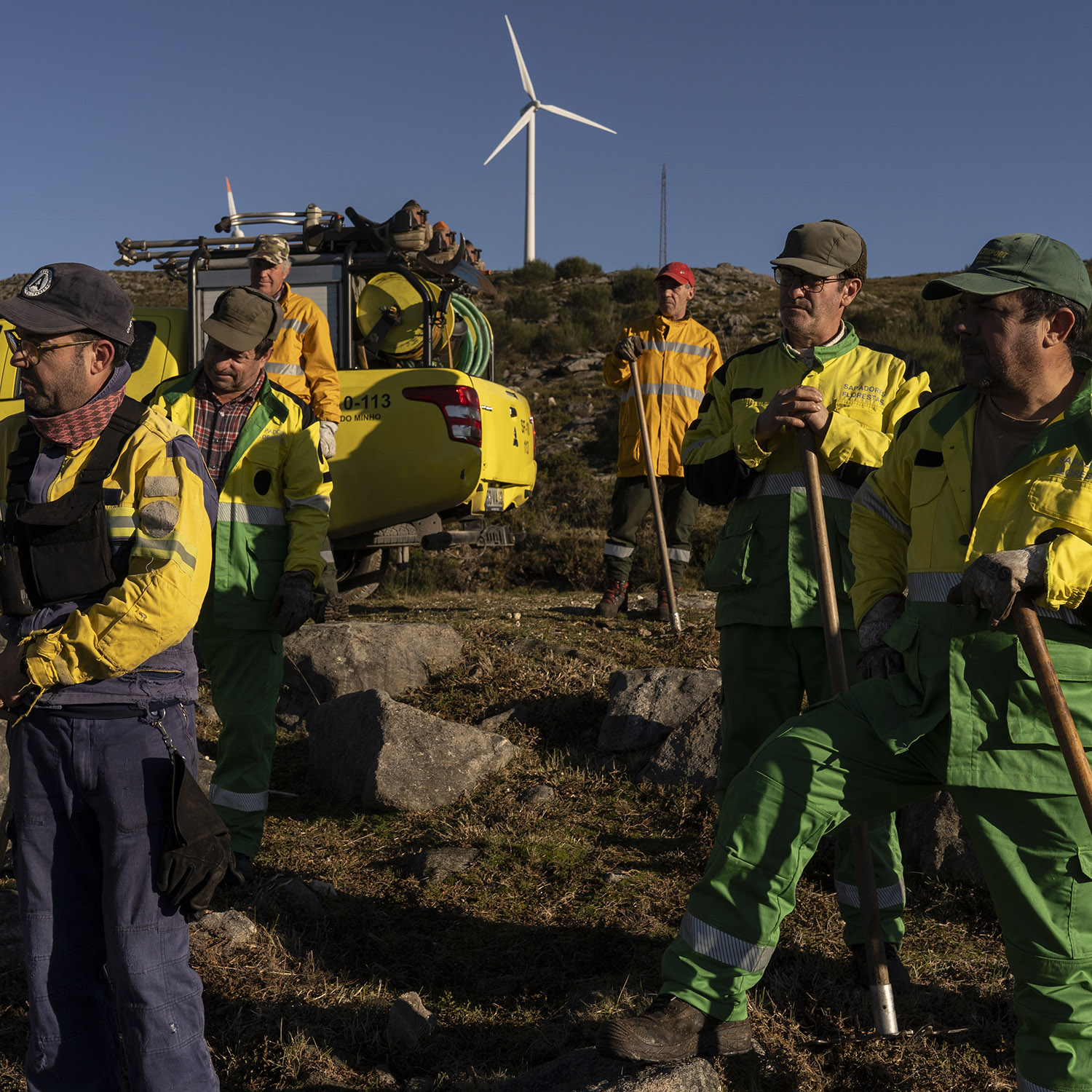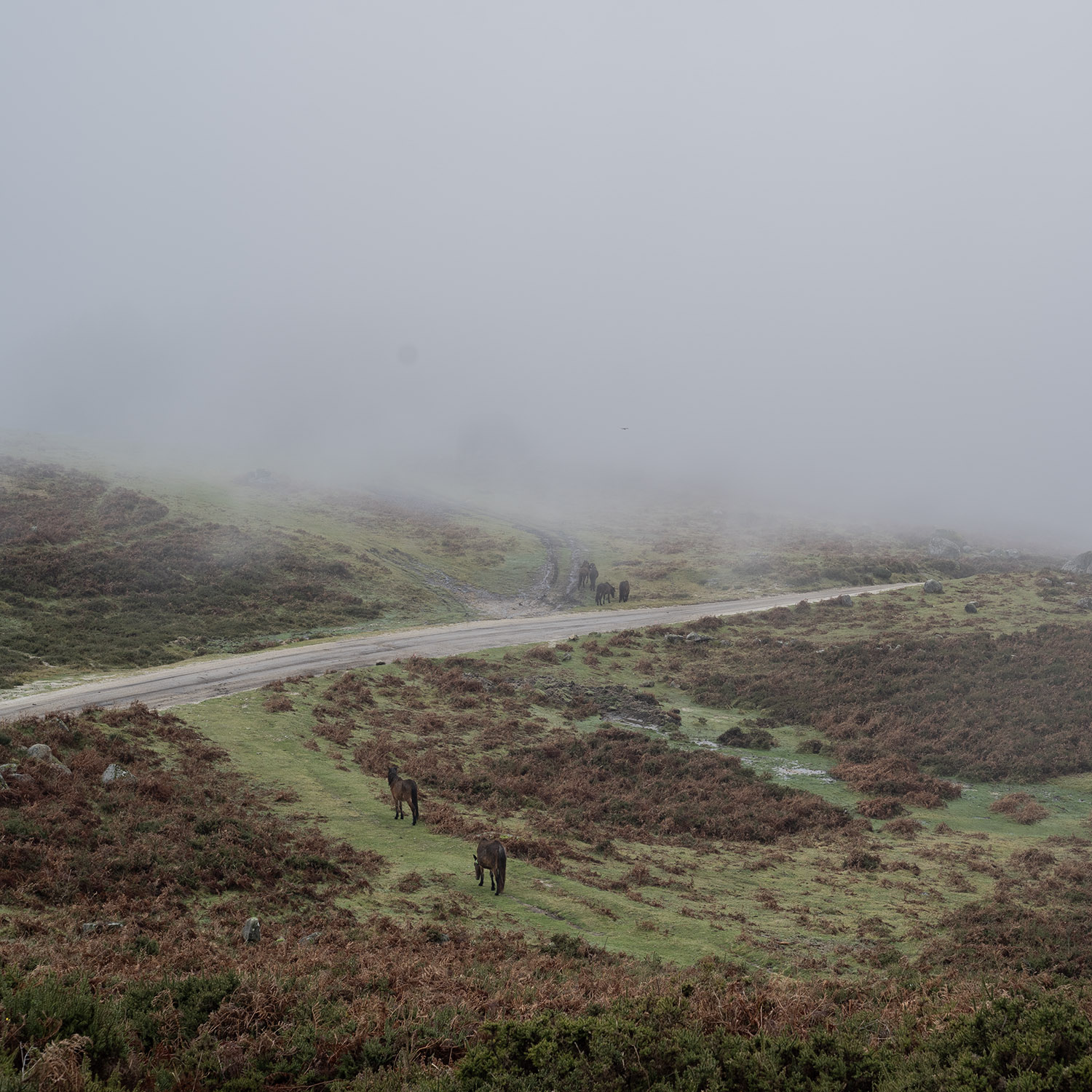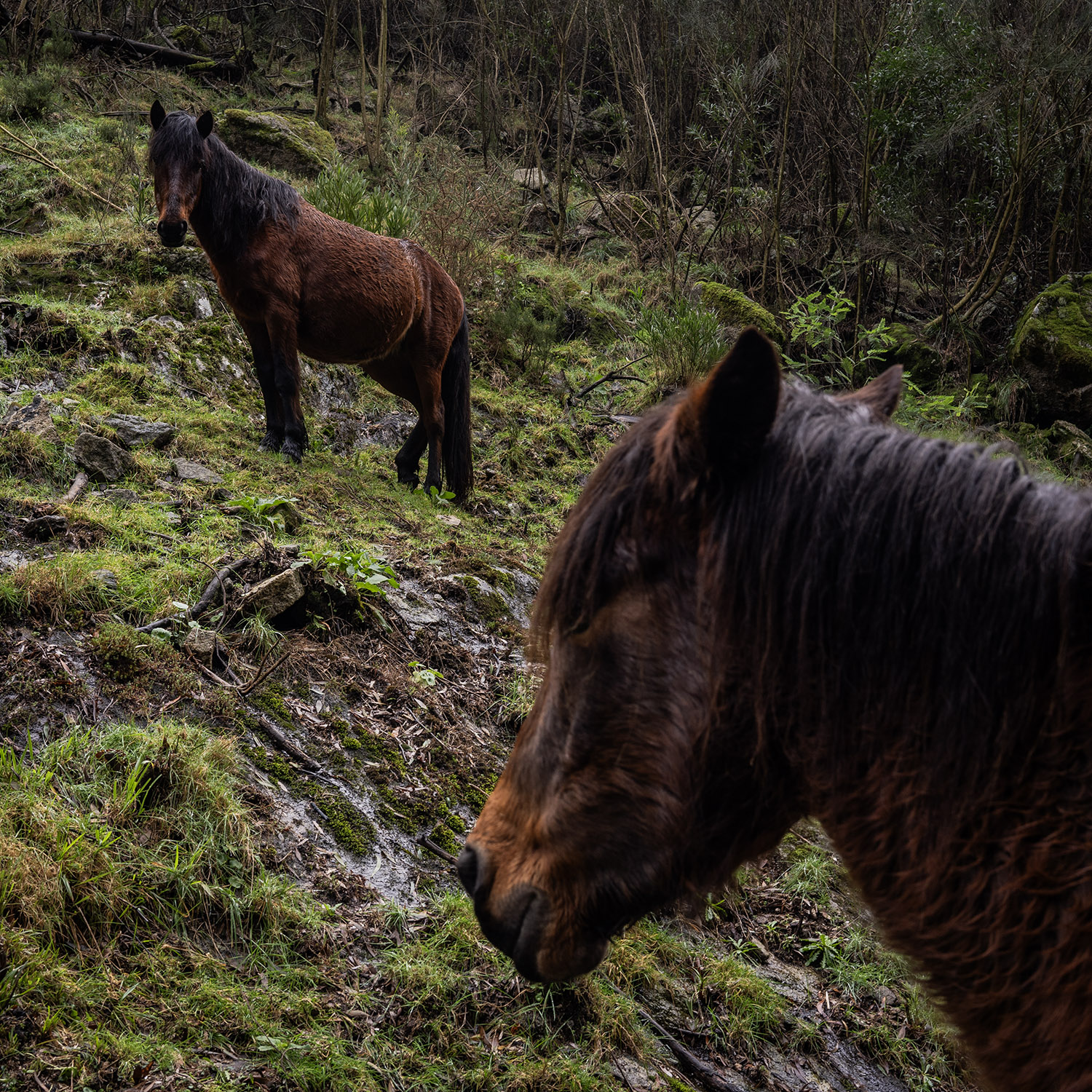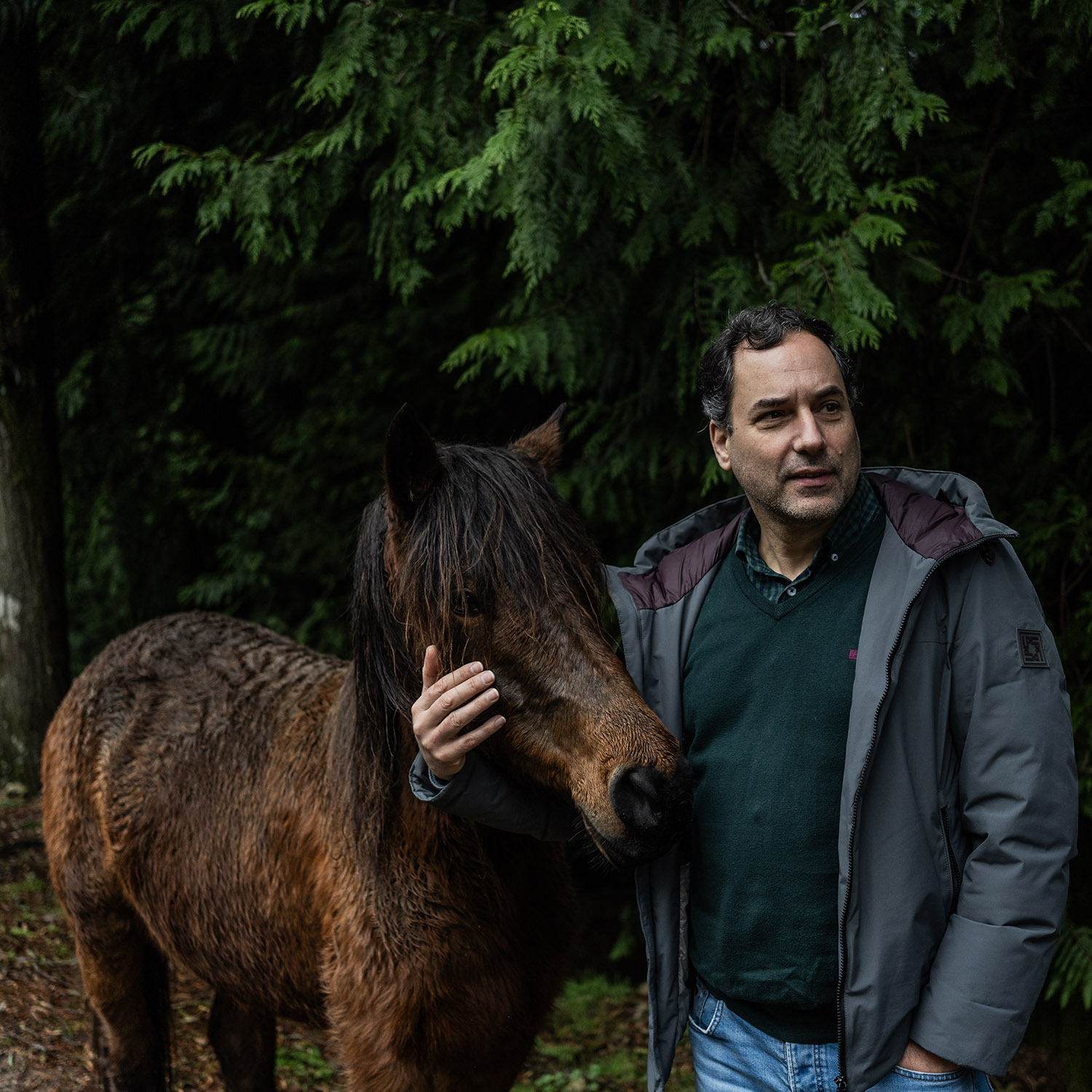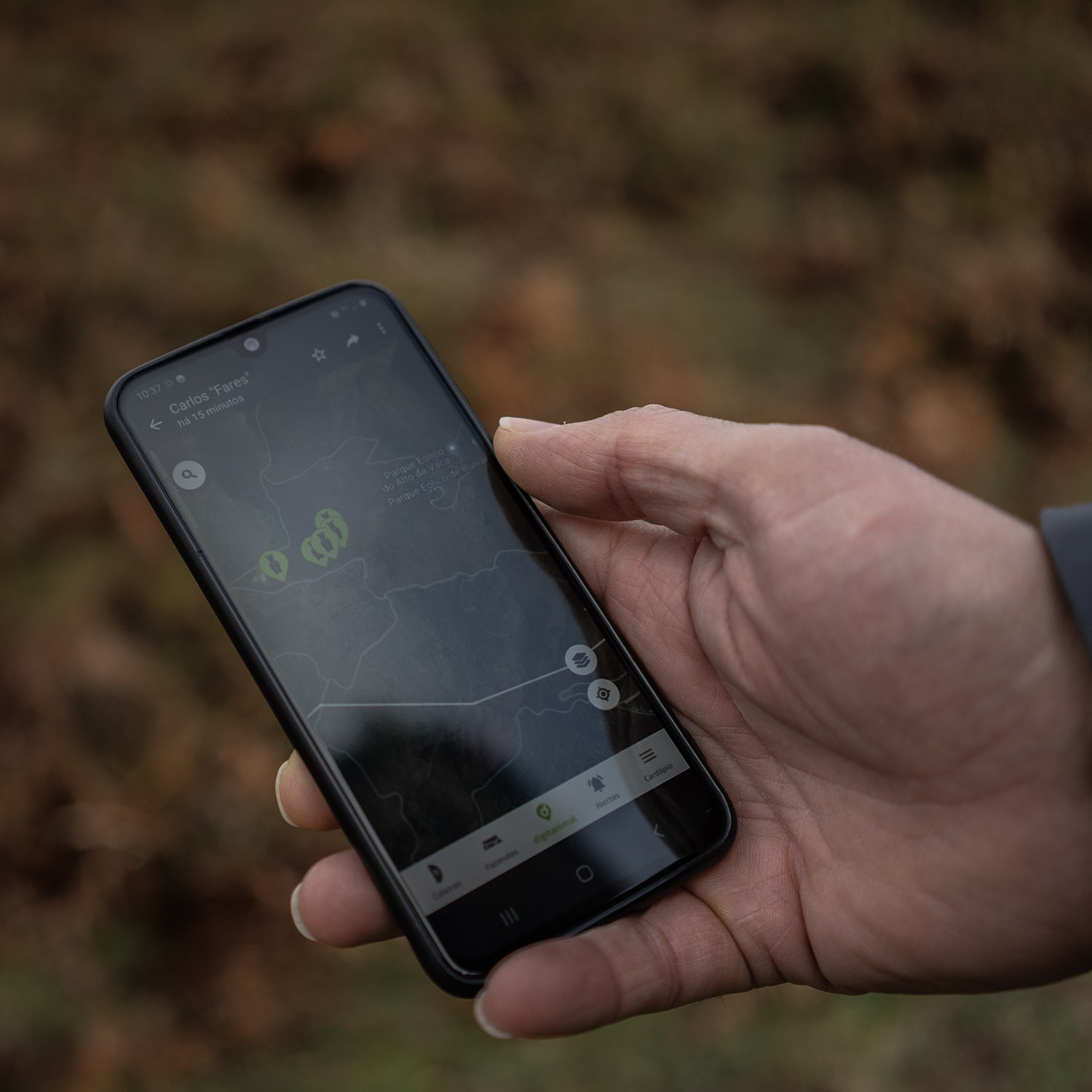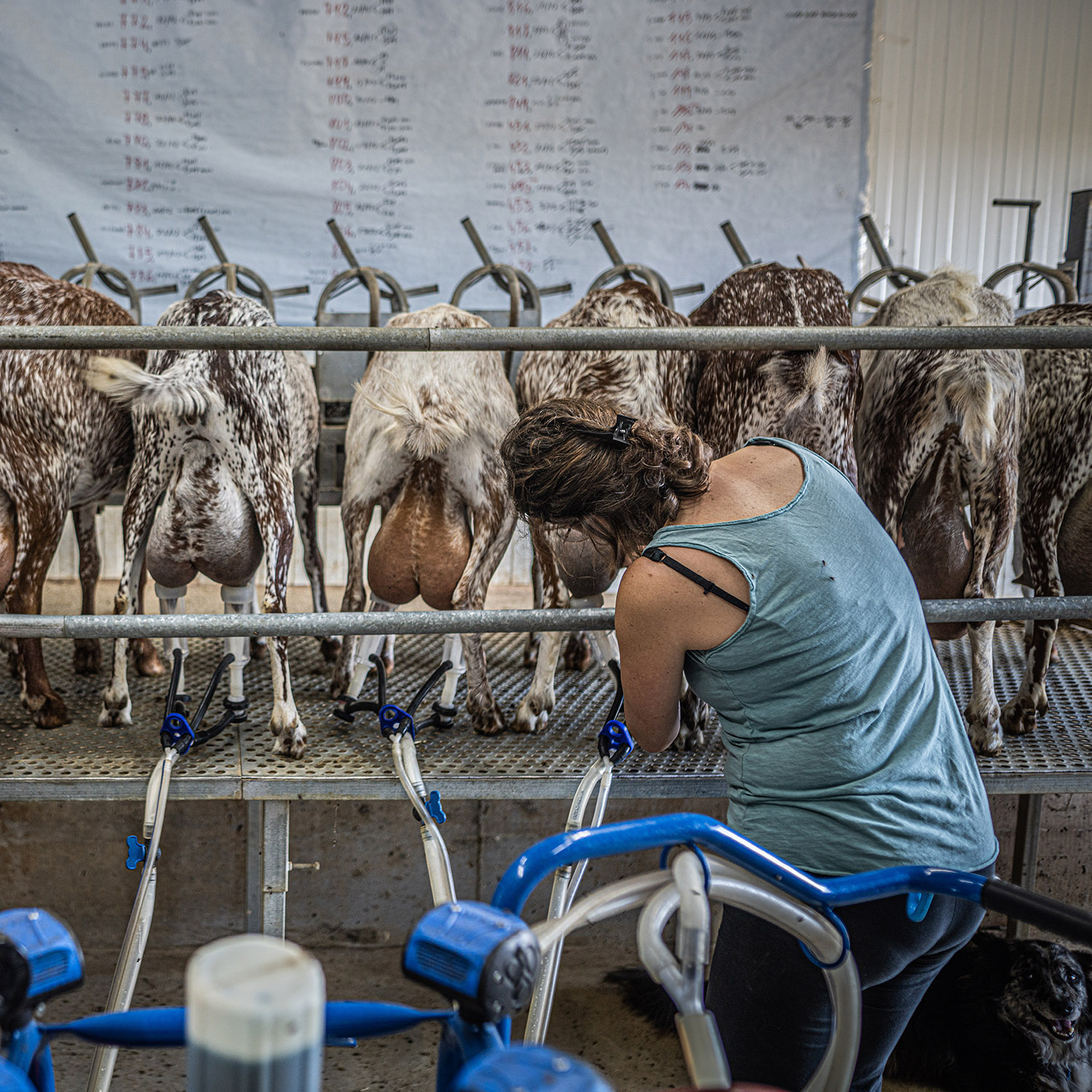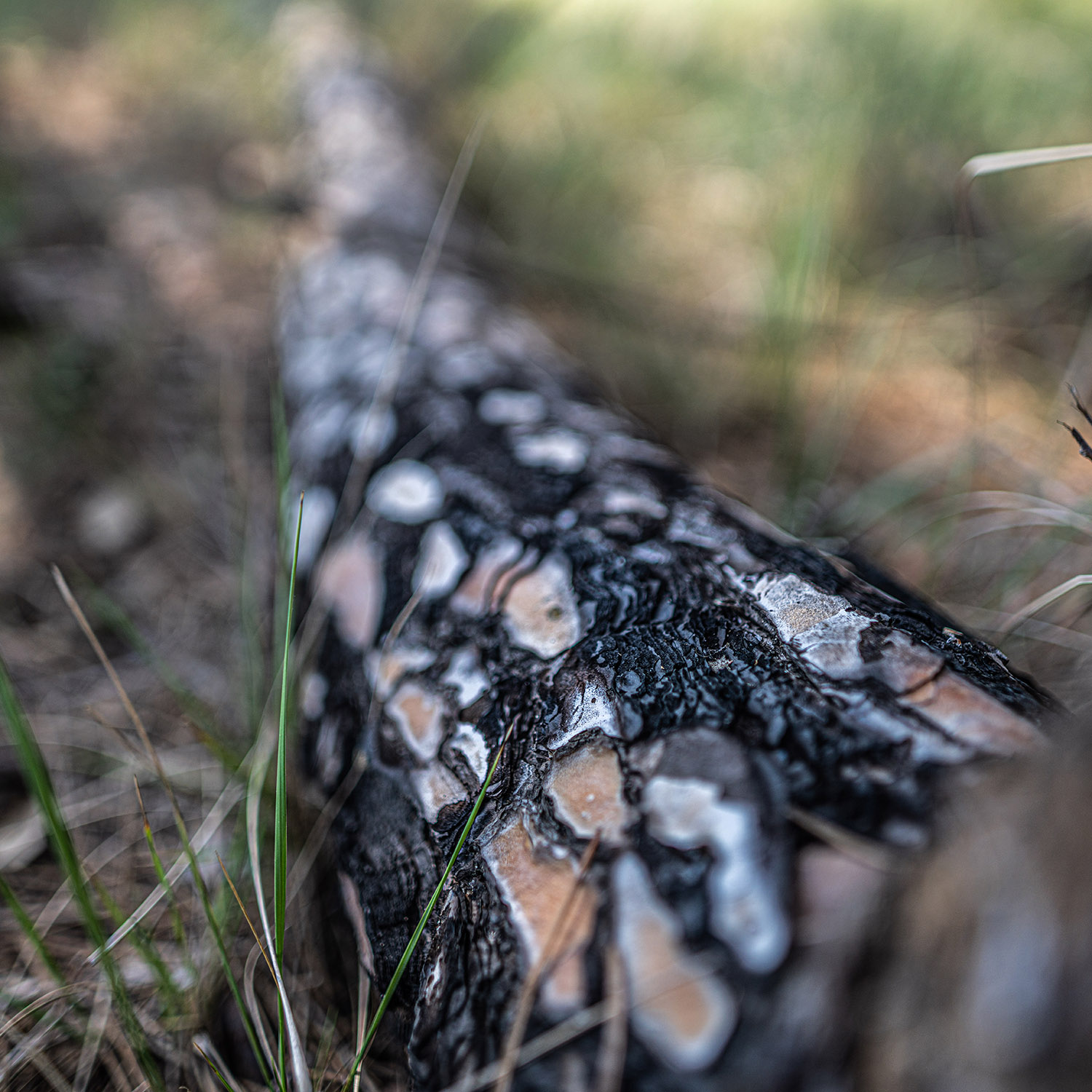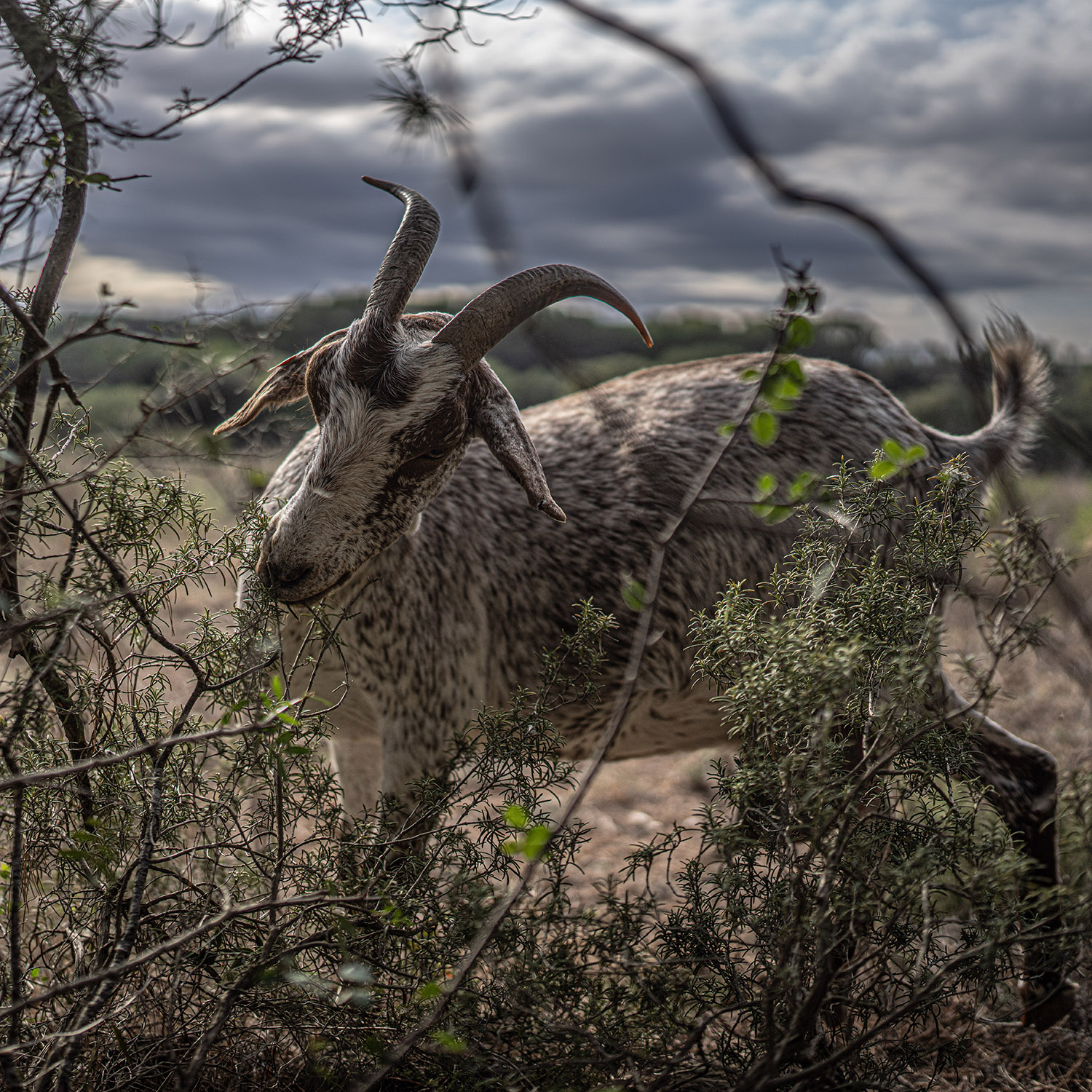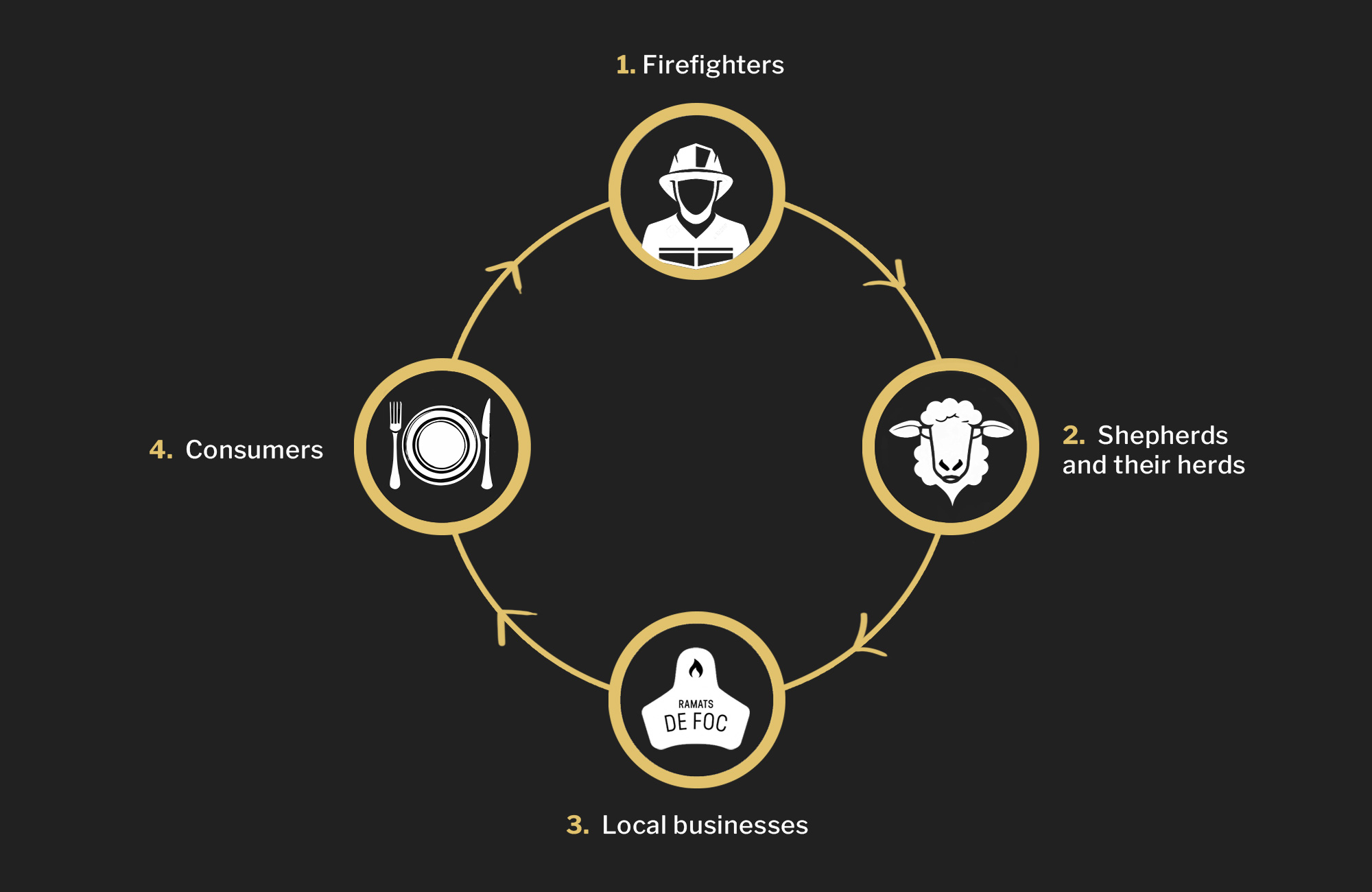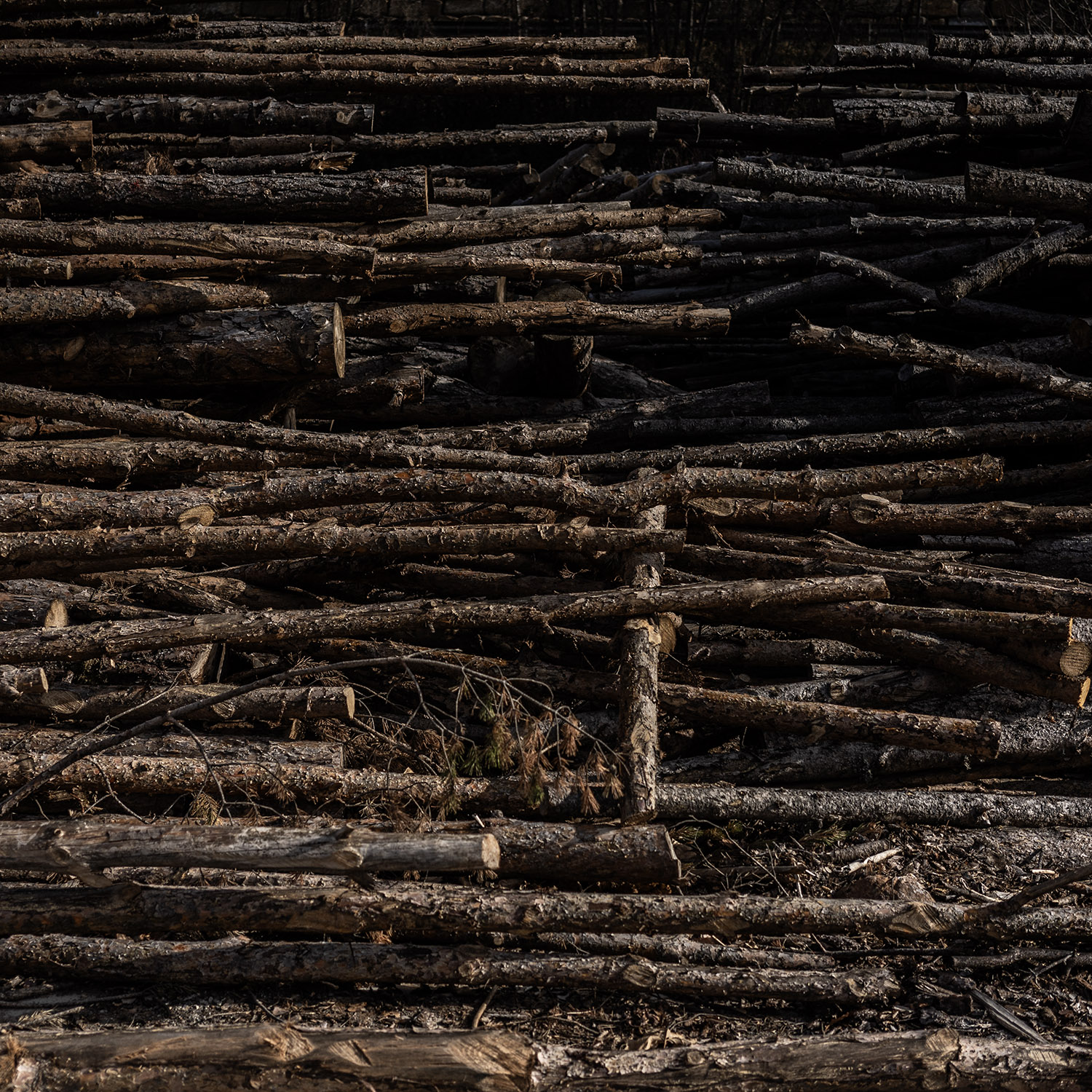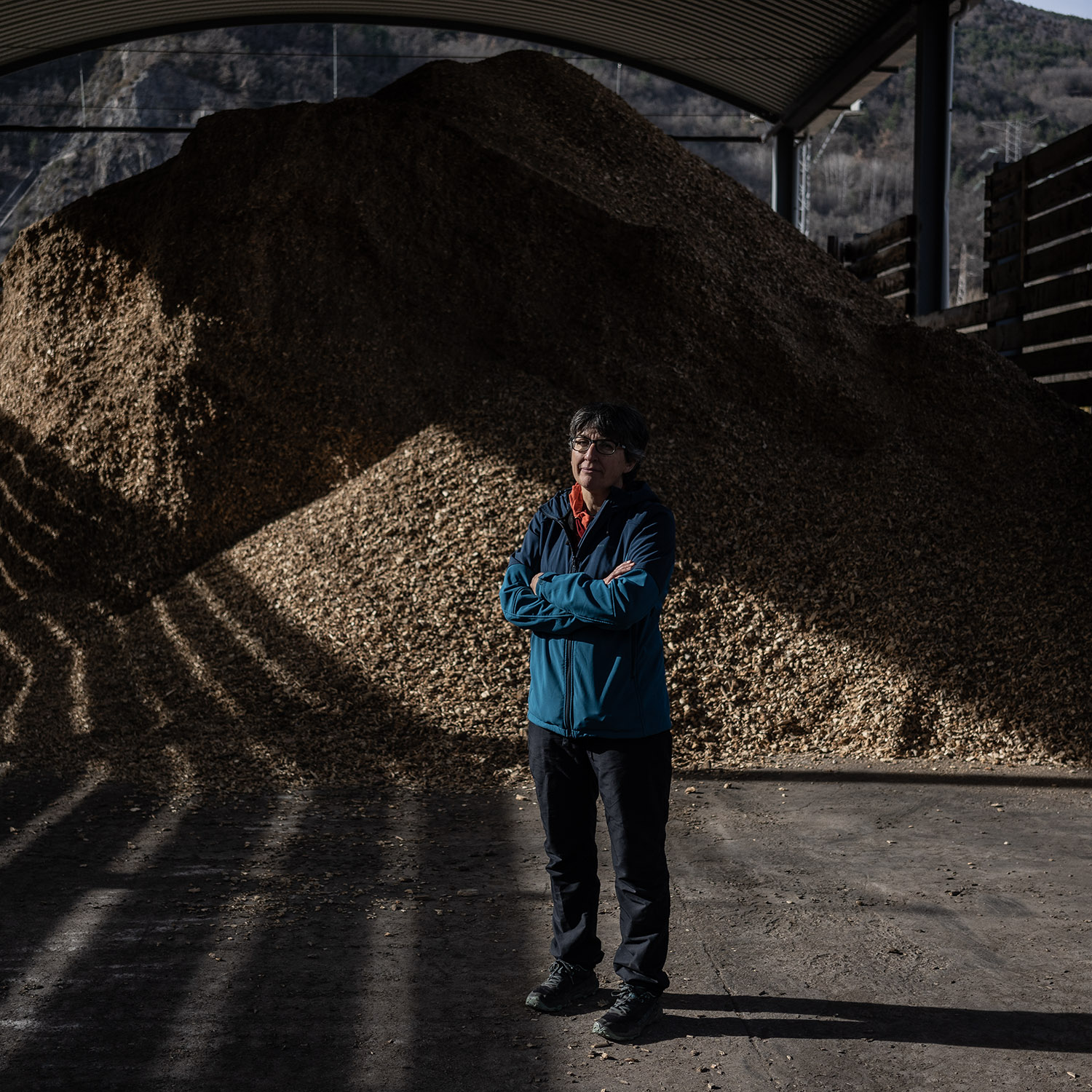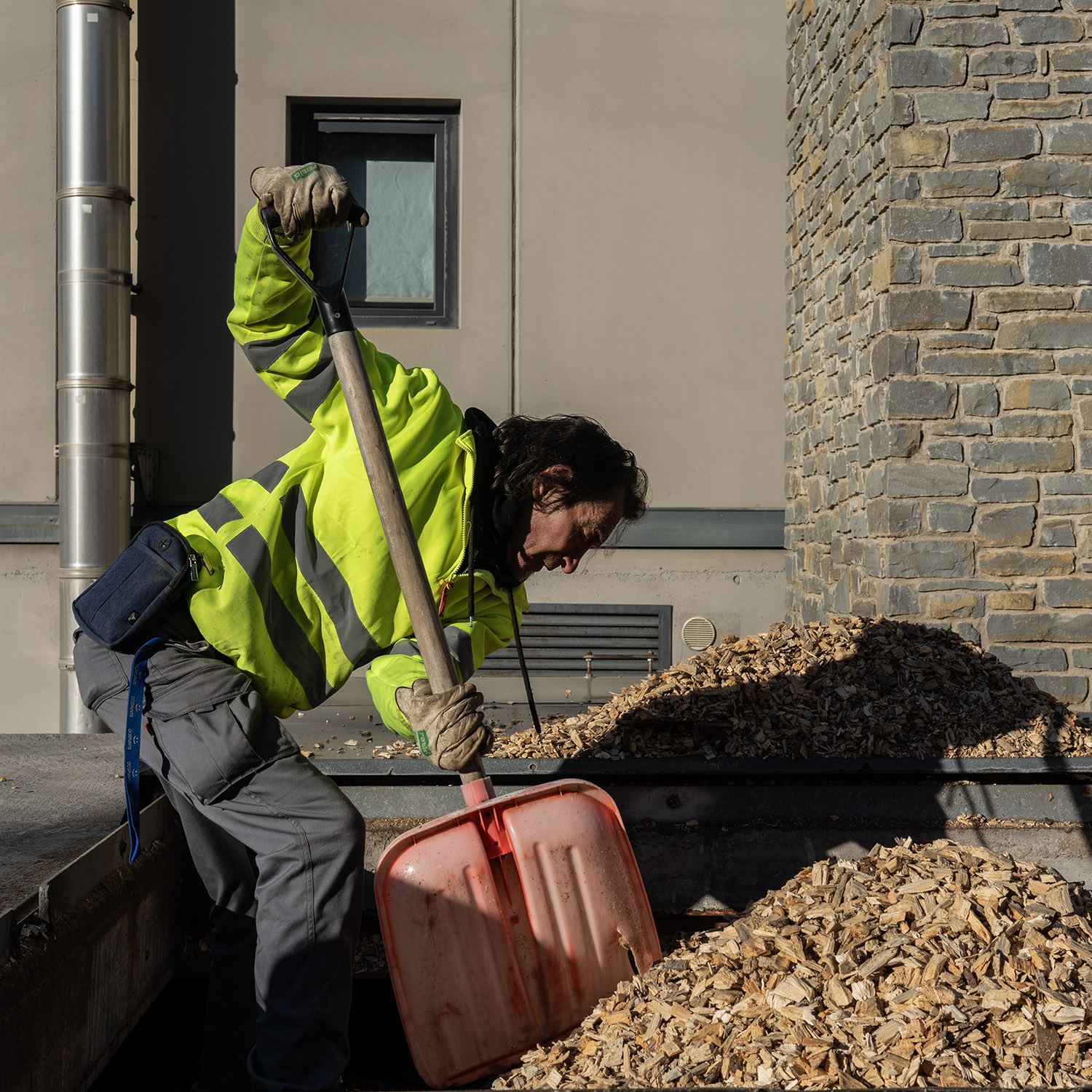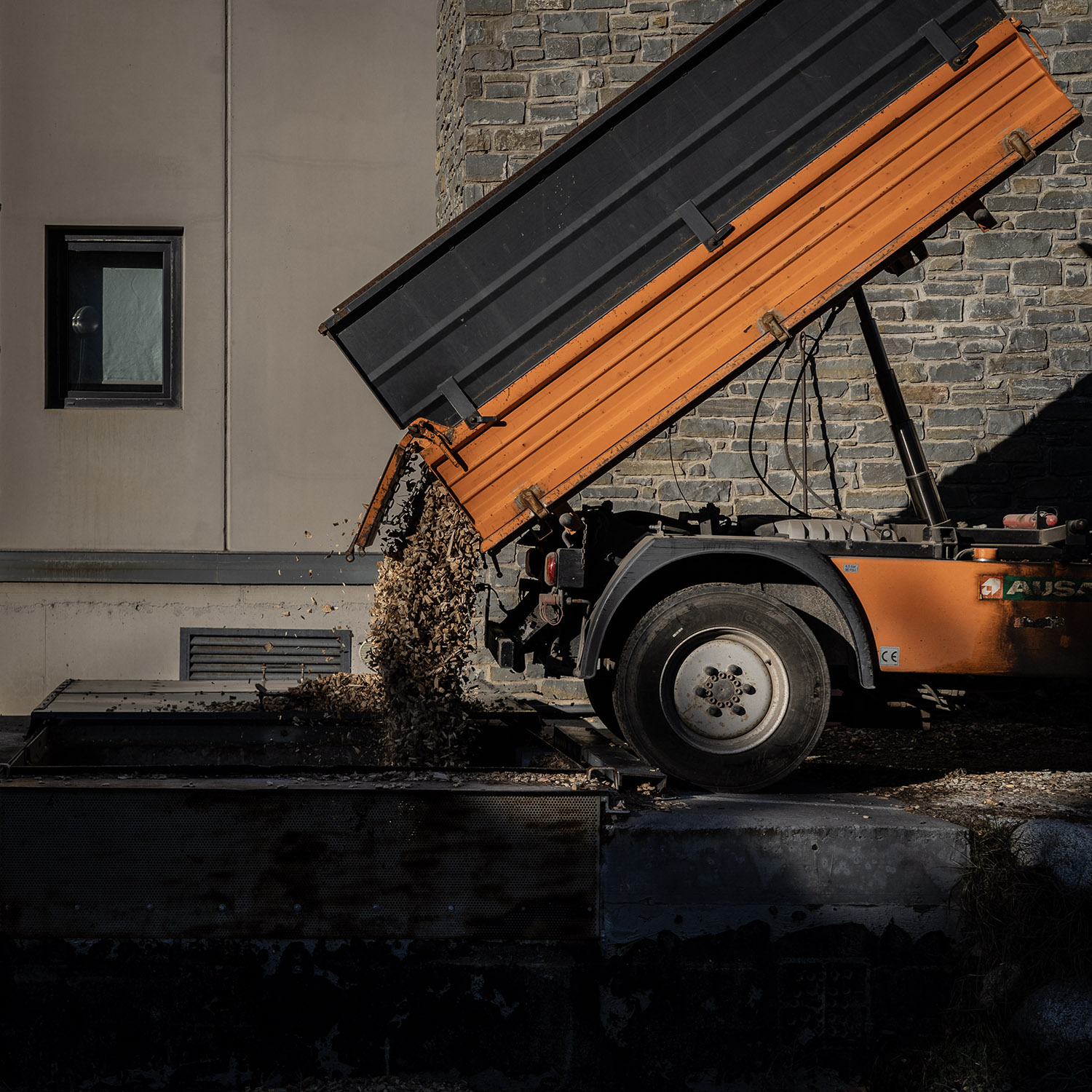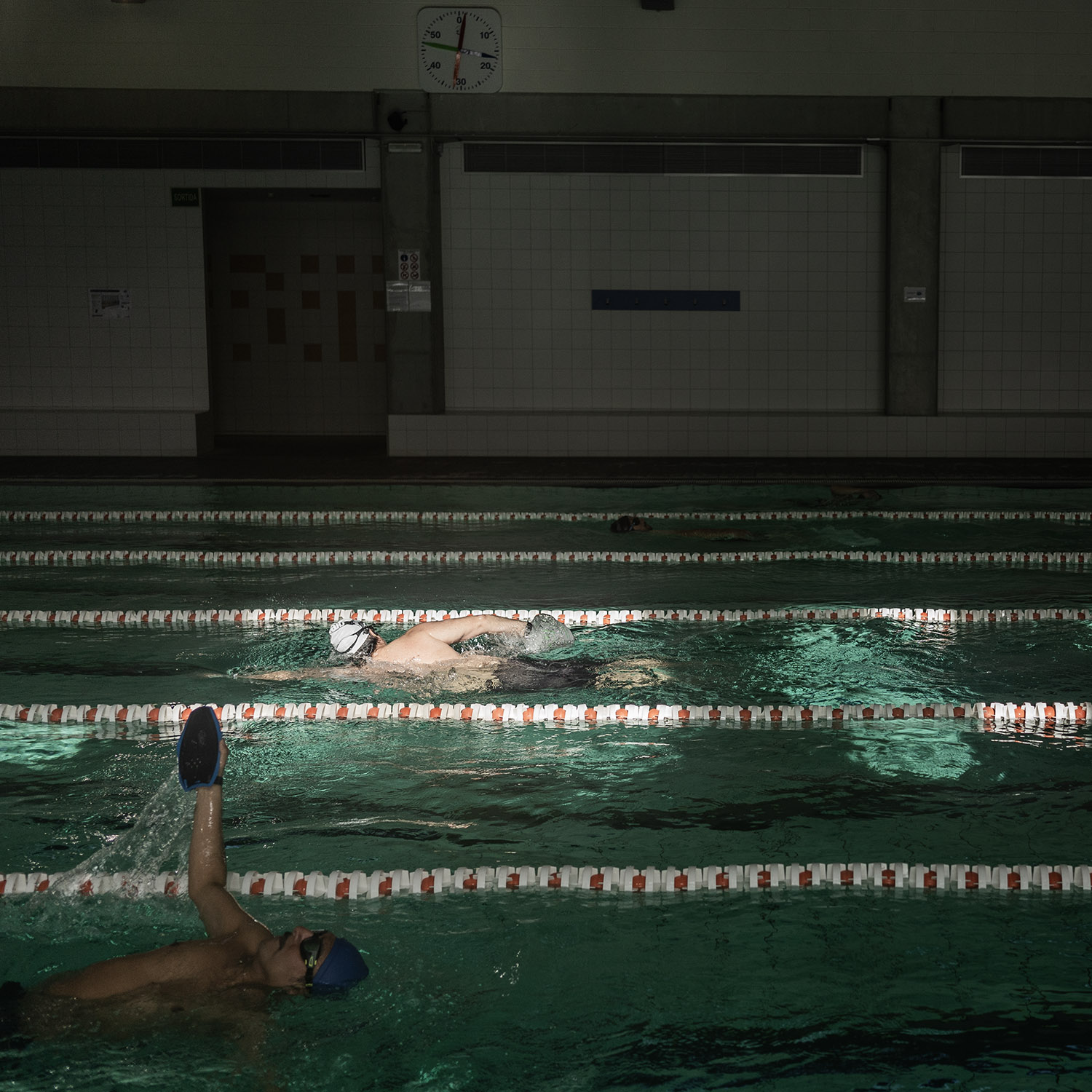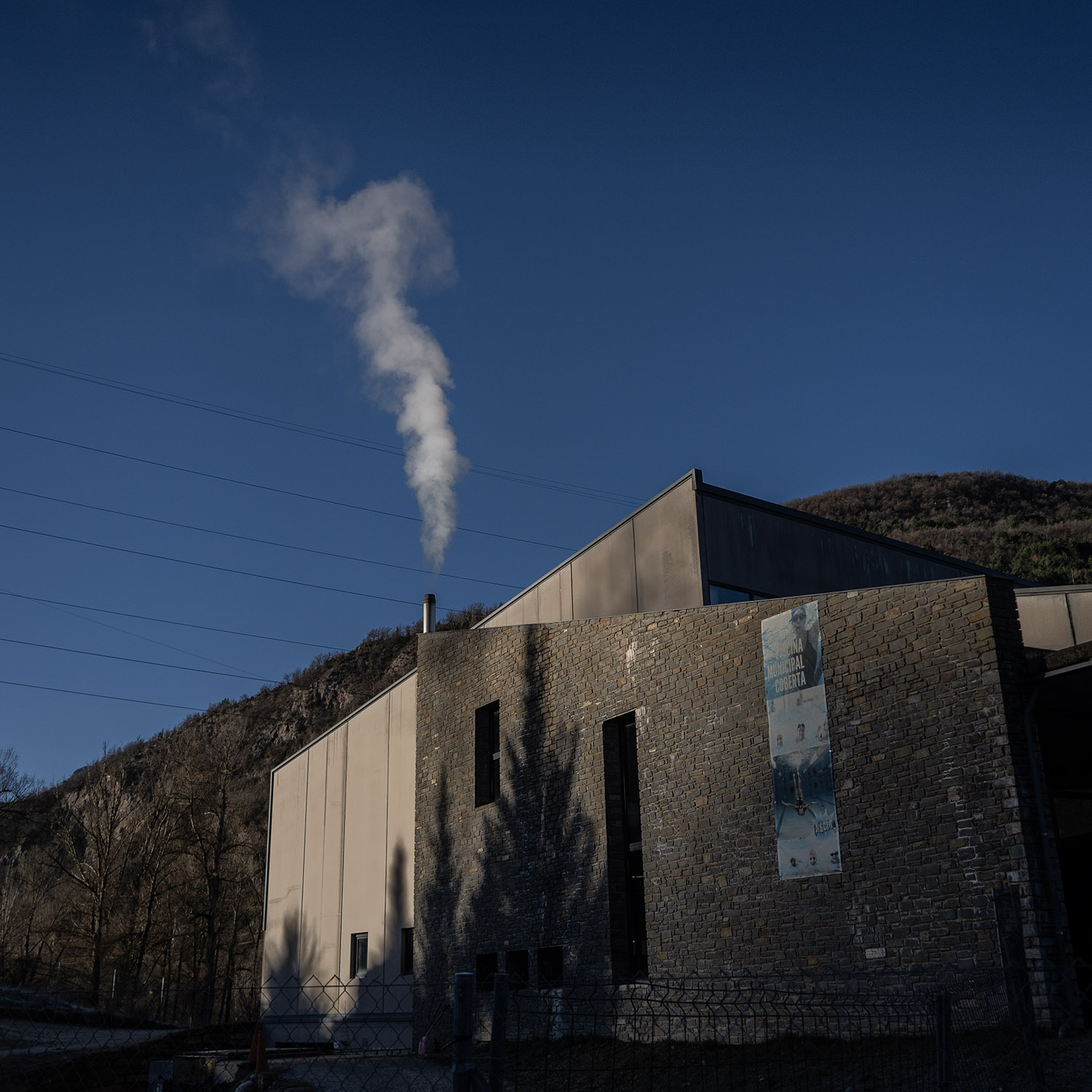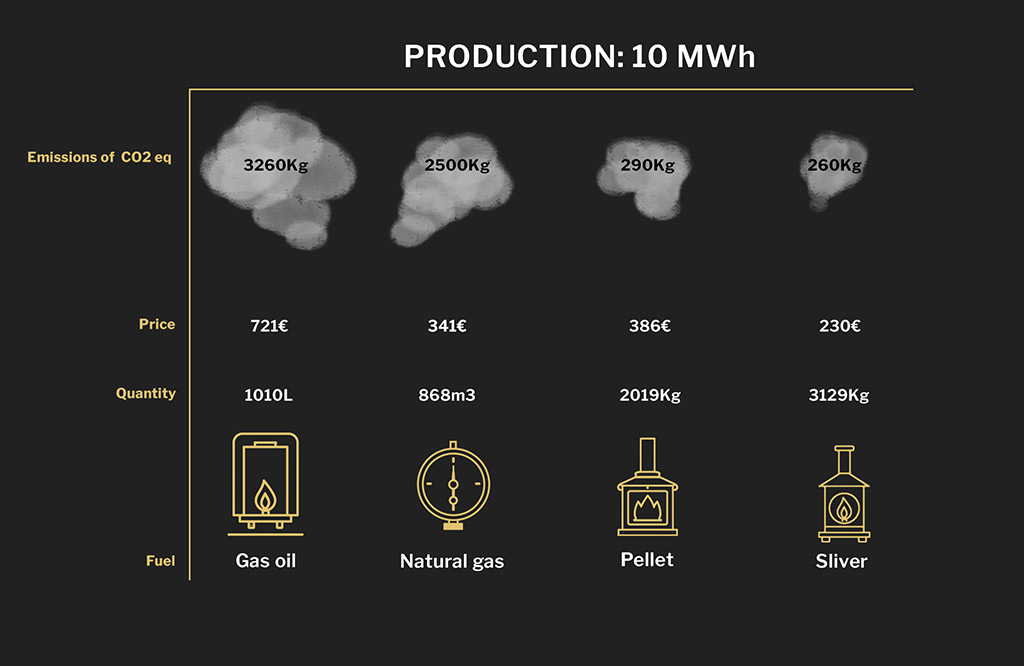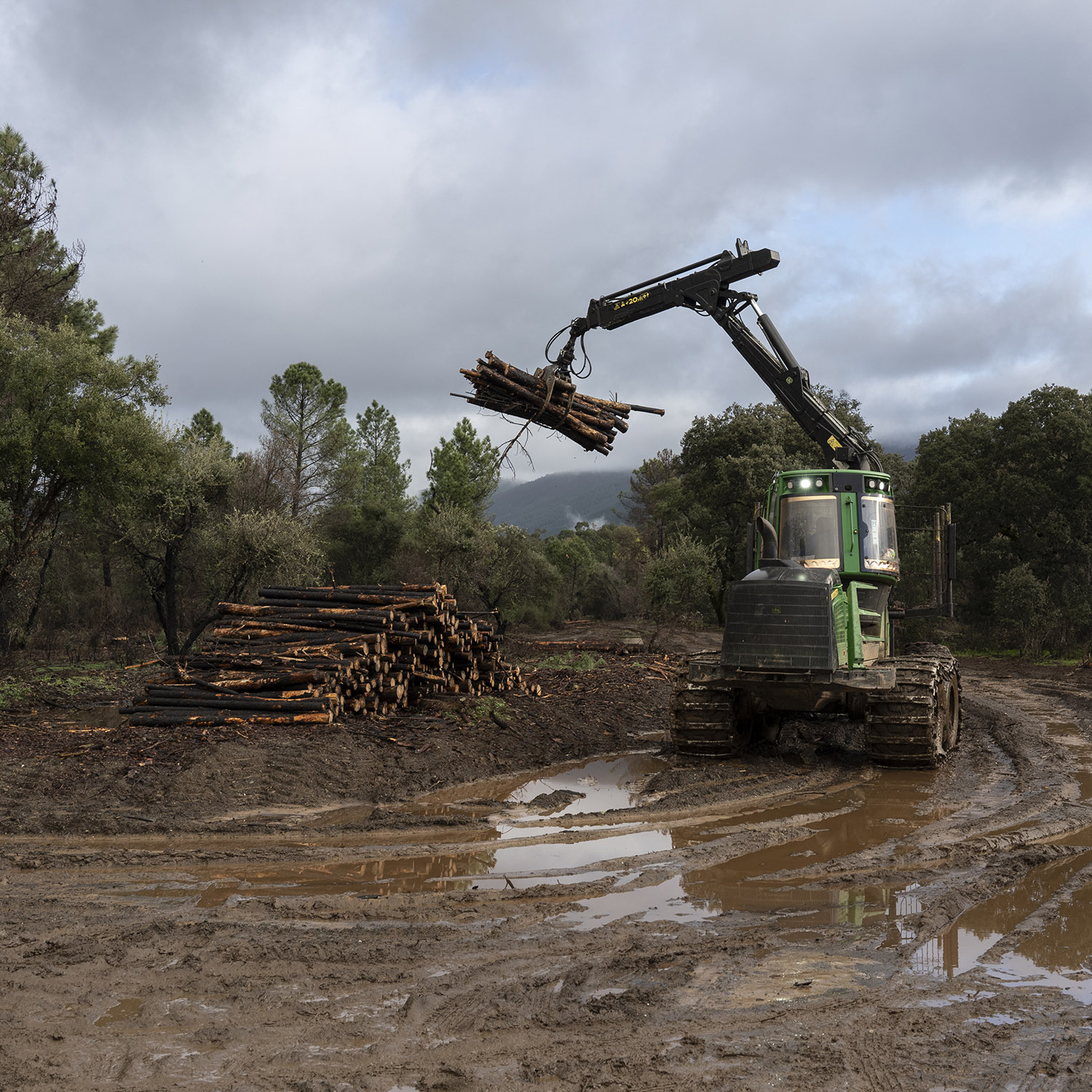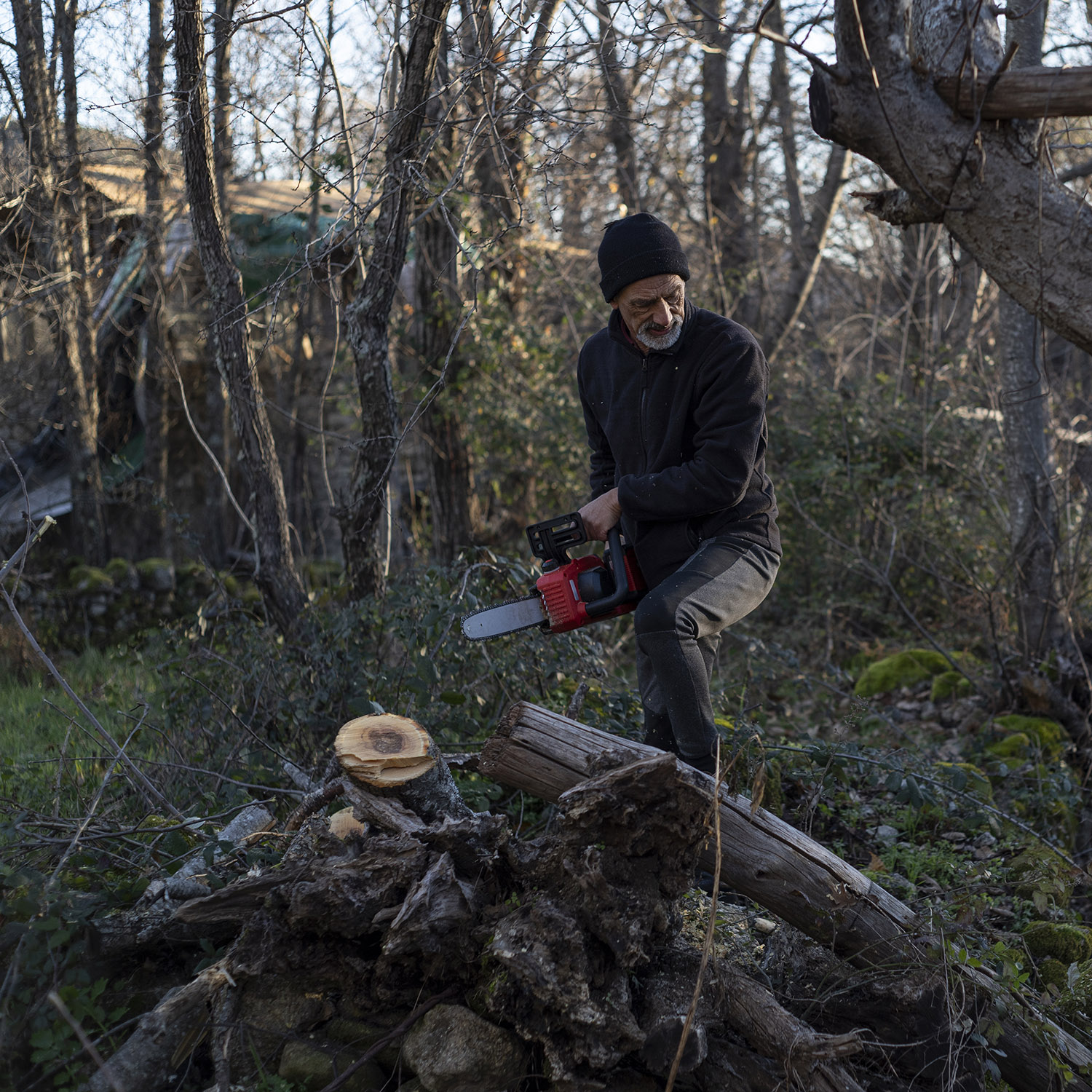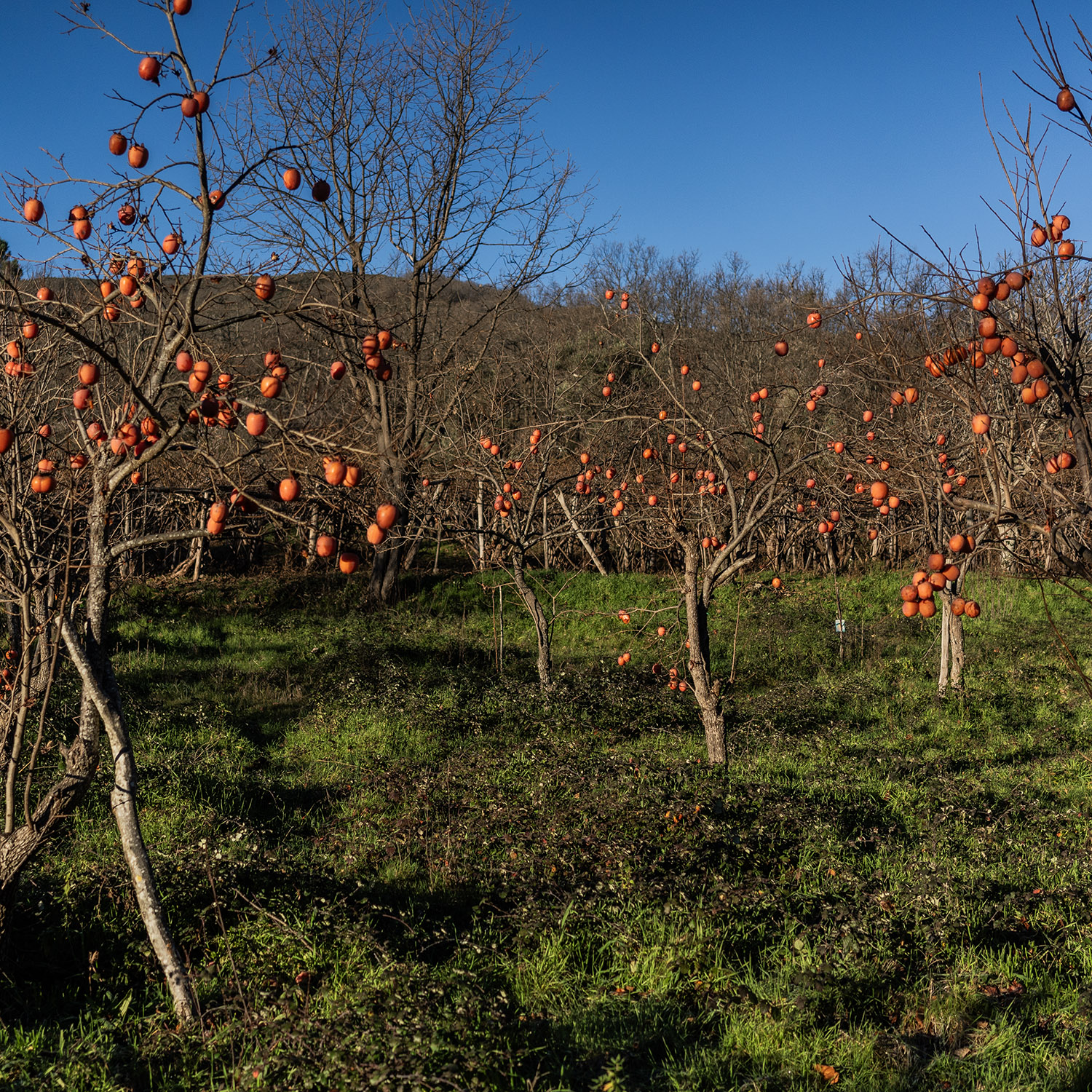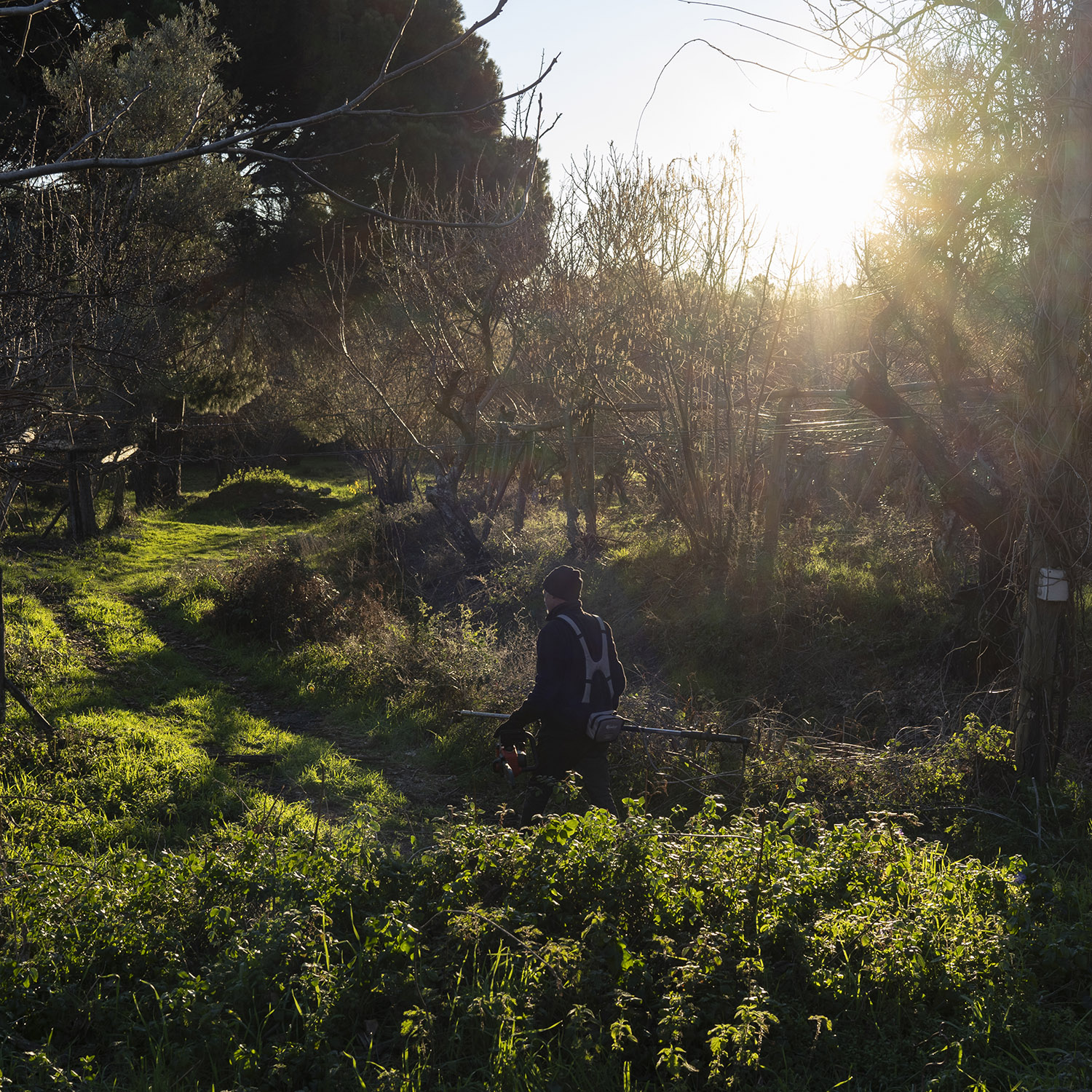This report was developed with the support of Journalismfund Europe.
Facing Fire
Smart solutions to the mega fire challenge
Nelson Rodrigues, a fire technician with the Vieira do Minho City Council, uses a drip torch to light gorse bushes during a prescribed burn in Serra da Cabreira, a mountain range in the Vieira do Minho district of northern Portugal. © Paulo Nunes dos Santos for Sonda Internacional
Project summary
#IIFFsondaMega Fires: Beyond Extinction
This project seeks to illustrate the circumstances surrounding the mega fires devastating Spain by generating a central guide to this phenomenon, presenting the new fire behavior and explaining its consequences on the land and the people. It will also compile the strategies for combating and living alongside them; unearth how ecosystems recover and utilize them; and share the solution projects mitigating their proliferation. As always, the project will tell these stories through photo, video and graphic resources as the main tool. Because seeing is essential to understanding.
Conversations #01: What is a mega fire?
Spanish Lapland
Fuelling a Mega Fire
Facing Fire
‘Lumes’ by Adra Pallón
Join our crowdfunding!
Take the opportunity to directly support in-depth journalism on the climate crisis
Donate
27 February 2024
Whether you’re aware of it or not, there has been a seismic shift in the goals of modern European firefighting. Strange as it may seem, the aim “is not to eliminate fire, because it is part of the natural dynamics of ecosystems, but to make fires less dangerous,” said Professor Fernando Pulido, director of the Dehesa Research Institute at the University of Extremadura. “Even with many resources, you cannot do complete fire prevention,” he added.
It’s a consensus many experts in fires and forestry have been trying to disseminate now for decades with varying results. They are unified in their prescription for a problem that is growing worse with every increasingly hot year: the only way to avoid destructive mega fires is through thoughtful land management and the controlled reintegration of fires into our ecosystems.
Aerial view of a prescribed burn in Serra da Cabreira, Braga district, northern Portugal. © Mikel Konate for Sonda Internacional
There is however no one golden bullet solution, the key to long-term mega fire prevention is the use of a mix of tools tailored to a territory’s needs. Across the Iberian Peninsula there are a number of international, national and local ‘fire smart’ initiatives being implemented in public and private forests including: the use of prescribed burns, extensive livestock grazing, agroforestry land mosaics and the extraction of trees and shrub litter for biomass energy resources. These solution projects break-up continuous fuel loads acting as a barrier to stop or slow fire while reducing the flammability of landscapes surrounding vulnerable towns and in many cases boosting rural development.
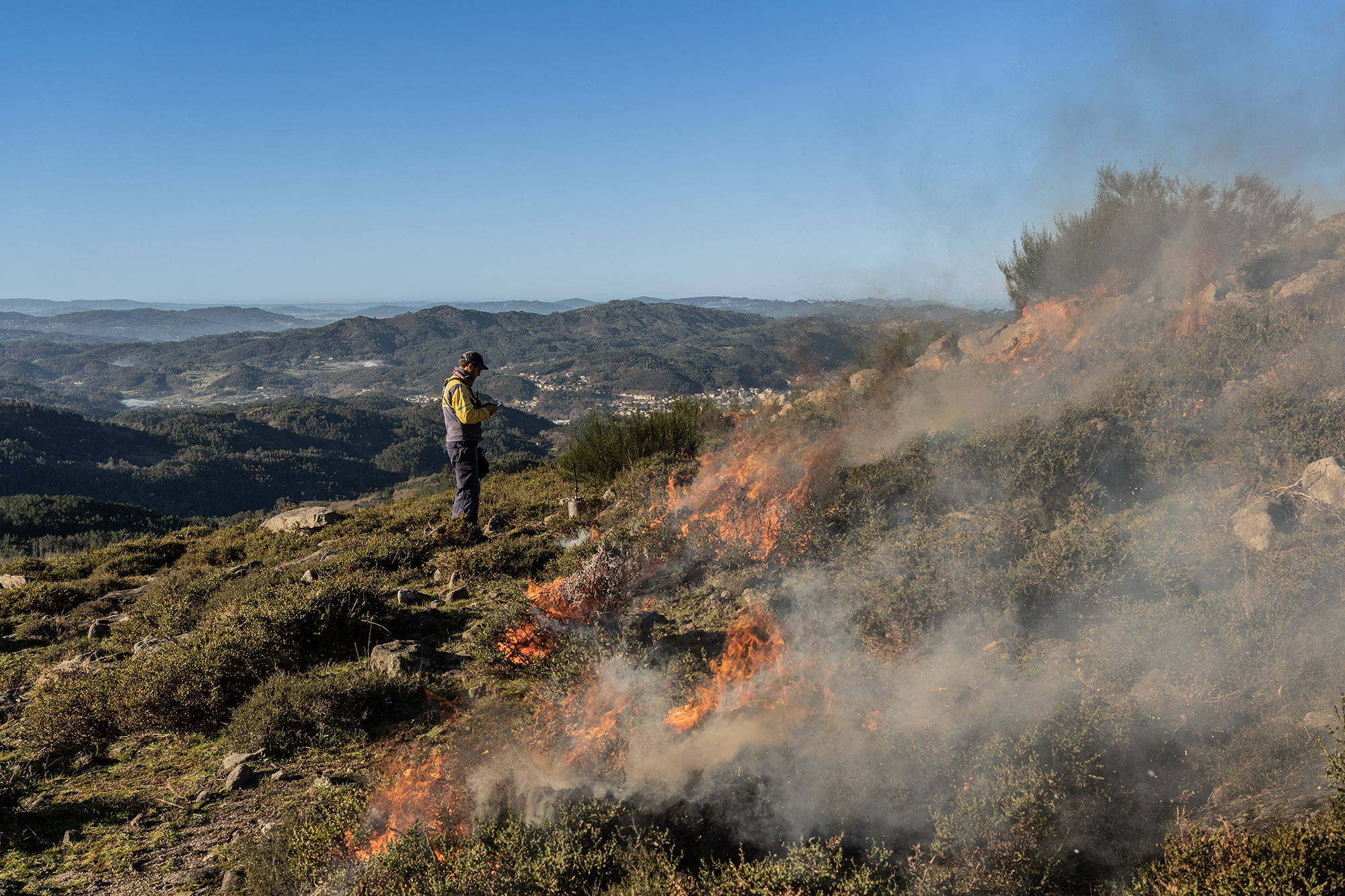
Nelson Rodrigues, fire technician from the Viera do Minho City Council, setting fire to gorse bushes during a prescribed burn in the mountains of the Serra da Cabreira in northern Portugal. © Paulo Nunes dos Santos for Sonda Internacional
FIGHTING FIRE WITH FIRE
Managing the land means allowing it to burn periodically to avoid untamable wildfires. This can be achieved in a controlled way, through the use of prescribed fires. These small, intentional fires reduce accumulated fuel loads, renew soils, increase water availability, create pastoral areas and importantly create firefighting pathways. In Portugal the tool has been used since the 1980s, being one of the first European countries to introduce a structured legal framework for the practice.
The Serra Cabreira mountain range, in the northern Portuguese region of Braga, is a shining example of authorities proactively using prescribed burning to keep vegetation undergrowth under control and extreme wildfires at bay. The aim is to avoid a disaster like the one that occurred in October 2017, near the municipality of Vieira do Minho, where 1600 hectares burned. At the time, the highly flammable carqueja shrub had grown over 1.5 meters high and enveloped much of the land. Because of the available fuel, fires raged from the valley to the mountaintop.
Nelson Rodrigues, fire technician from the Vieira do Minho City Council, uses a drip torch to set fire to gorse bushes during a prescribed burn in the mountains of the Serra da Cabreira in northern Portugal. © Mikel Konate for Sonda Internacional
Prescribed fires can’t just be lit and left. Before any flame is sparked, fire technicians in Portugal must have a burn plan approved by the National Institute for Nature Conservation and Forests (ICNF). In Spain, prescribed burning is regulated according to the provisions of each Autonomous Community. After approval, they must wait for the ideal on-site weather conditions. The window for burning is typically only open for 10 weeks a year between November and March and requires dry but not parched soil, substantial wind speeds, high relative humidity and low temperatures. The specially trained teams control the fire’s progression using drip torches, wind speed and direction, slope, vegetation density and hand-held mops to suppress spot fires.
Nelson Rodrigues, 49, is the Vieira do Minho municipal council’s head fire technician specializing in prescribed burns and fire analysis. In five year cycles he and his team have been burning parcels of the Cabreira mountain range. He explains the difference between prescribed fires and wildfires is in the severity of the burn. “A natural fire destroys the vegetation, destroys the soil and then in the next rains the [burnt] soil is washed away and only the rocks remain. [With prescribed burns] we are now burning the top part of the vegetation, the plant doesn't die, the roots don’t die, it remains fixed to the soil and in about a month it will start to grow again.”
Nelson is confident, due to their interventions, a mega fire would not be able to develop in the area he controls. It’s a long-term achievement that fills him with pride, “Imagine that we [have] worked on a landscape for a few years and during the next few years there were never big fires. No habitat was destroyed, no type of forest or environment. And it was possible for us to all work together, shepherds, technicians, hunters and farmers.”
Fundamental to the program's success is that coordination. “We need pasture and the way to have pasture is through fire.” Shepherds themselves traditionally used fire to create clearings for their animals, but in recent decades there has been a shift away from traditional fires to authorized burns carried out by technicians. “[Now] it has to be done by technicians, so it is up to us to approach the shepherds and the simplest way is to go to their place and be with them, explaining that they need fires in the territory and it doesn't need to be hidden or criminalized, so we can jointly define the areas and work together,” Rodrigues said.
Paulo Manuel Martins Ribeiro, 51, lives on the outskirts of Vieira do Minho with his herd of more than 300 goats. He is one of the shepherds routinely working with Rodrigues. The burns secure pastures, as well as open clearings where it is more difficult for predators such as wolves to attack herds. Martins says each year wolves kill at least 60 of his goats. “The broom (Giesta) is an invasive plant. If controlled burning is not done, there will come a point when there will be no grazing areas because it will take over the entire Serra da Cabreira," he said.
© Mikel Konate for Sonda Internacional
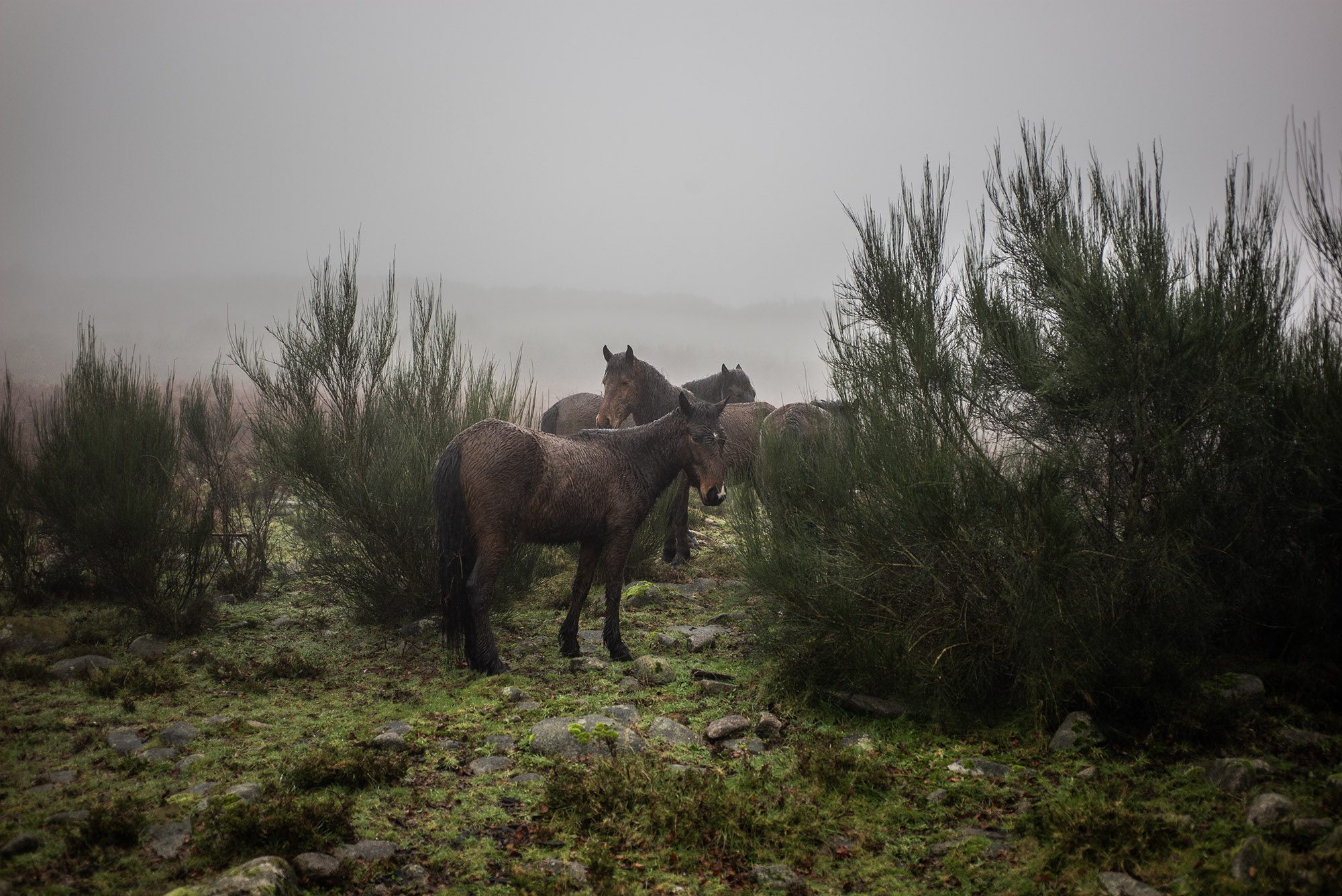
A herd of Garrano ponies grazing in Serra da Cabreira, northern Portugal. © Paulo Nunes dos Santos for Sonda Internacional
‘SAPADORES’ PONIES
After a prescribed fire, animals of the area flock to the burn scar knowing the soil’s fresh nutrients will soon follow. In the Cabreira mountains the first to arrive is a herd of semi wild native Garrano ponies. The rare breed are known as “sapadores” (fire fighters in Portuguese) because they also function as fire fuel managers. Their grazing doesn’t remove the vegetation completely but stabilizes and controls its rate of growth. So effective is their grazing that in 2022 the Garrano Horse Breeders Association (ACERG) made a deal with electrical company, REN, and the Vieira do Minho Council’s Association for the Planning of Serra da Cabreira (APOSC) to more formally use the ponies for fire prevention.
Under the agreement a herd of 300 horses graze over about 100 hectares of land surrounding REN power lines to maintain the vegetation. “If it weren’t for the horses, this area would be overgrown,” said ACERG president, João Paulo Carneiro Ribeiro, 53. Unlike cattle who are picky about what they eat, the ponies will devour everything in their path, each chewing about 10-15 kilos of vegetation a day and up to 4500 kilos all together. “It eats anything that is green or burnt. It is an animal that eats anything to survive," Carneiro said.
The herd are left to graze wildly but monitored and tracked using GPS collars placed on leading mares. João Paulo Carneiro Ribeiro is confident the initiative could be replicated on similar terrain across the Peninsula. “Everybody talks about the first fires [of the season] and fire prevention. But only during fire season, in the critical time. We don't talk about it all year round and in my view fire prevention should happen all year round. Firefighters, fire brigades, Civil Protection have to work all year round not just in the spring and summer when the high temperatures arise,” Carneiro said.
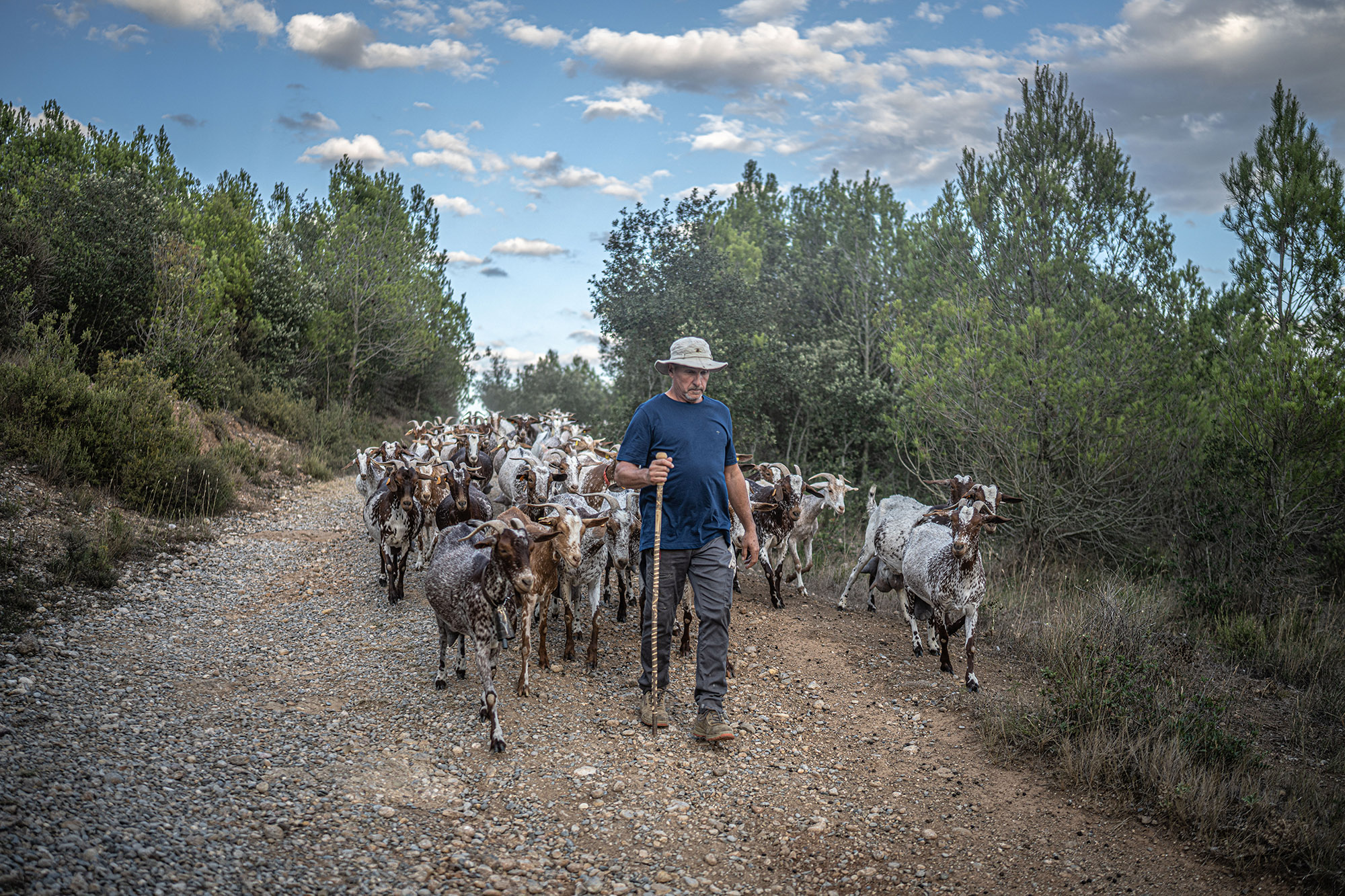
Joan Martí Quer, Judit Nadal’s husband, leads a herd of goats in the community of Gaüses, in the province of Girona. © Pablo Tosco for Sonda Internacional
FIRE FLOCKS
There are other silvopastoral programs reducing fire risk that are even more established across the Peninsula like Catalonia's Ramats de Foc (Fire Flock) program created in 2017. The initiative sees herds of goats and sheep graze in ‘understory vegetation control target areas’ predefined by Catalonia’s firefighters and the Department of Agriculture. Eighty shepherds now manage about 8,500 hectares of land across Catalonia.
“Our goats act as the gardeners of our environment,” said Judit Nadal Feixas, 51, who first joined the program with 30 goats from her Gaüses farm in the comarca of Baix Empordà. “What the goats do is eat in the bush up to the height they reach, which could normally be up to one and a half meters. They reduce the part of the undergrowth in ways so in the case of a fire there is no vegetation that can burn with vertical continuity.”
The program has the added value of being economically self-sustainable through a ‘circular bioeconomy’ model with a chain of dairy and meat by-products sold to stores, butchers and restaurants under a recognizable brand. Locals now buy the products with the understanding they’re funding fire reduction in their region. Judit and her husband Joan sell their goats cheese and meat under the Ramats de Foc seal supporting the cost efficiency of their extensive grazing work. “The goats feed on the undergrowth. Their meat is quality because they have been fed with a quality product. And selling the cheese, in this case organic, allows us to close the circle of the project,” she said.
© Pablo Tosco for Sonda Internacional
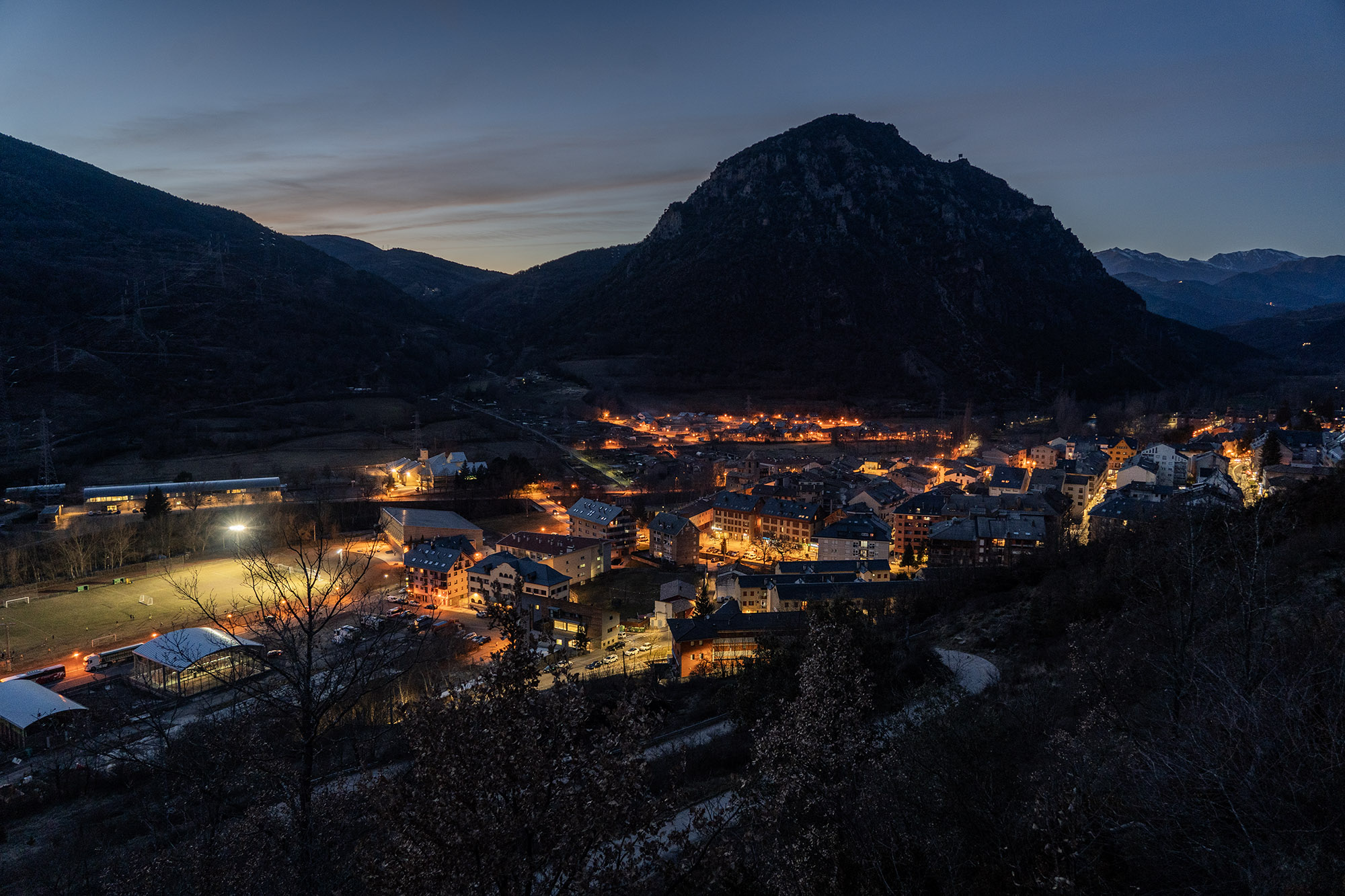
General view of El Pont de Suert, a town in the Alt Perineal region of Catalonia, where biomass extracted from the surrounding forests is being used to heat public buildings. © Paulo Nunes dos Santos for Sonda Internacional
FOREST FUEL
Another solution utilizing a circular bioeconomy structure is the extraction of raw forest materials or biomass in areas of high fire risk for the production of renewable energy. Studies are increasingly recognising the role biomass extraction could play in fire management strategies, yet despite its potential in both Spain and Portugal it is still a relatively underutilized resource.
The small town of El Pont de Suert in the Catalan Pyrenees, with a population of about 2,200 people, has been preventing extreme wildfires through forest thinning for the creation of biomass energy for the last nine years. To create the biofuel, wood residues are collected from the public forest, dried out, reduced to small wood chips and then used for heating in municipal buildings like the local pool, day care centre and library. The biofuel replaces natural gas and diesel oil, which in the case of the latter, costs more than three times the price and emits more than 12 times the CO2 to produce 10 MWh of energy. “The fact that this biomass stays in the town and saves on all the diesel or natural gas or all the heating that had to be spent in these facilities, well of course, for me it is the perfect circle,” said lead coordinator of the project, engineer and forestry technician, Anna Ivars, 46, of the Catalan Government.
The initiative is warming council buildings but its long-term objective is to promote the strength of the forest through active management and selective clearing. Like many forests in the region, the dense pines surrounding El Pont de Suert were planted in the reforestation push of the mid 1900s. Now around 1000 tonnes of biomass is consumed in public facilities annually. “The wood of better quality is sold,” said Ivars, and the rest, “small trees that are crooked, forked trees, wood that is not suitable for sawing,” is used for biomass.
Anna Ivars ensures 70% of the forest’s strongest and most vital trees remain untouched in order to balance the needs of the ecosystem. Ivars works patiently as it’s long-term work she does for future generations to enjoy, “It is a very young project, because of course nine years in the forest is nothing, it is nothing when these trees are already 60 years old,” she said, “I am working for the future.”
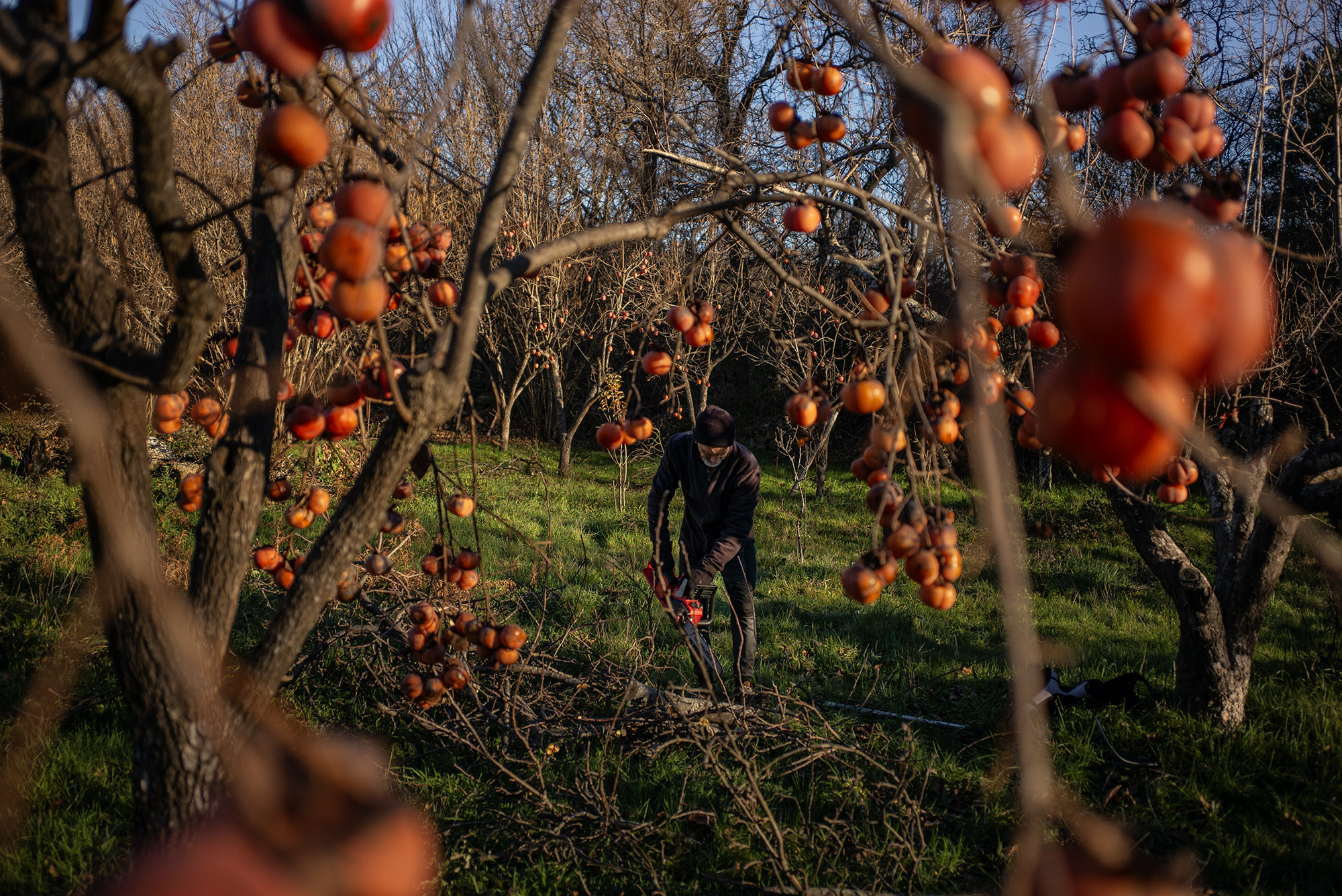
Carlos Donoso, a farmer and pioneer of the Mosaic project in the Extremadura region, uses an electric chainsaw to cut persimmon branches on his organic farm in the village of Acebo, Cáceres province, Spain. © Paulo Nunes dos Santos for Sonda Internacional
MOSAIC LANDSCAPES
The rural populations of Spain and Portugal have dramatically reduced in the last half century creating expansive empty spaces and overgrown forests which are creeping increasingly closer to populated urban areas. Between 1960 and 2021, Portugal’s rural population decreased from 5.7 million to 3.3 million, i.e. from 65% to 33% of the total population. In Spain in the same time period the rural population declined from 13.2 million or 43% to 8.9 million 19% according to the World Bank. The Spanish community of Extremadura is one of the most evident cases. “[We] have half the population we had in the past but the target landscape is the same, so you have to work with other tools," Professor Fernando Pulido said.
A burnt area affected by the Las Hurdes fire of May 2023 surrounds several hectares of olive groves, in the province of Cáceres, Extremadura, Spain. © Mikel Konate for Sonda International
One such tool, combining multiple land management strategies is: mosaic landscapes, also known as ‘fire smart territories’. Mega fires can’t easily develop or spread through land that’s cultivated, grazed, surveilled and managed, making these land mosaics a vital part of wildfire risk reduction. The most effective are called ’strategic productive firebreaks’ which are areas used to grow crops contributing to the bioeconomy while focusing on critical areas of high fire risk.
Professor Pulido conceived the program in 2016 with the University of Extremadura. “In these marginal lands the forest by natural regeneration grows 2% every year, so you don't need to plant, you need to manage and drive the forest in the direction you need. This idea that we need trees everywhere here does not work,” he said. The program currently has 102 productive firebreaks across Las Hurdes, Sierra de Gata and the Sierra de San Pedro Occidental including resin extraction, forestry, crop farming and livestock grazing across 6167 hectares of land, reducing the area’s fire risk by 10%.
Mosaic representation of the different forms of land use and management being implemented in the province of Cáceres, Extremadura, Spain. © Mikel Konate for Sonda Internacional
Importantly land owners involved in the project, including those redesigning land for fire prevention, are given technical and administrative support to access subsidies and navigate the complicated and time-consuming bureaucracy associated with effective land management. “Here the bureaucracy is reaching somewhat ridiculous and absurd limits," criticizes farmer Carlos Donoso, 64, who is one of the pioneers of the initiative. He explains, exasperated, that permissions to plant new trees, for example, can take up to two years.
His property, Becerril Farm, sits on 80 hectares of land just outside the town of Acebo, Cáceres and hosts various fruit orchards including apple and persimmon trees and forests of cork oak and chestnut trees. Carlos thinks of his property as a fire smart island in the sea of abandoned pine plantations that encircle it. And he has witnessed the power it can have, “In the great Acebo fire [of 2015], our farm was practically one of the very few in town that did not burn. It is clear: native forest, with livestock and with a little care, acts as a brake,” A break that’s potentially life saving, given the nearest fire station is almost an hour away in Coria.
A positive by-product these fire smart initiatives share is their ability to directly combat land desertification by attracting and holding populations in rural areas. Carlos Donoso, believes they can help revitalize towns that are emptying and aging: “Some people are coming, but there's still plenty of room and a lot more people could come," Donoso said. He believes for both fire prevention and sustainable land management people must be encouraged to return to rural areas and be helped by administrations to sustain the economic activity that justifies them staying. But ultimately, he says, "Those of us who live here are the ones who have to take an active part. In the end it is the local population that has to take control of its own destiny.”
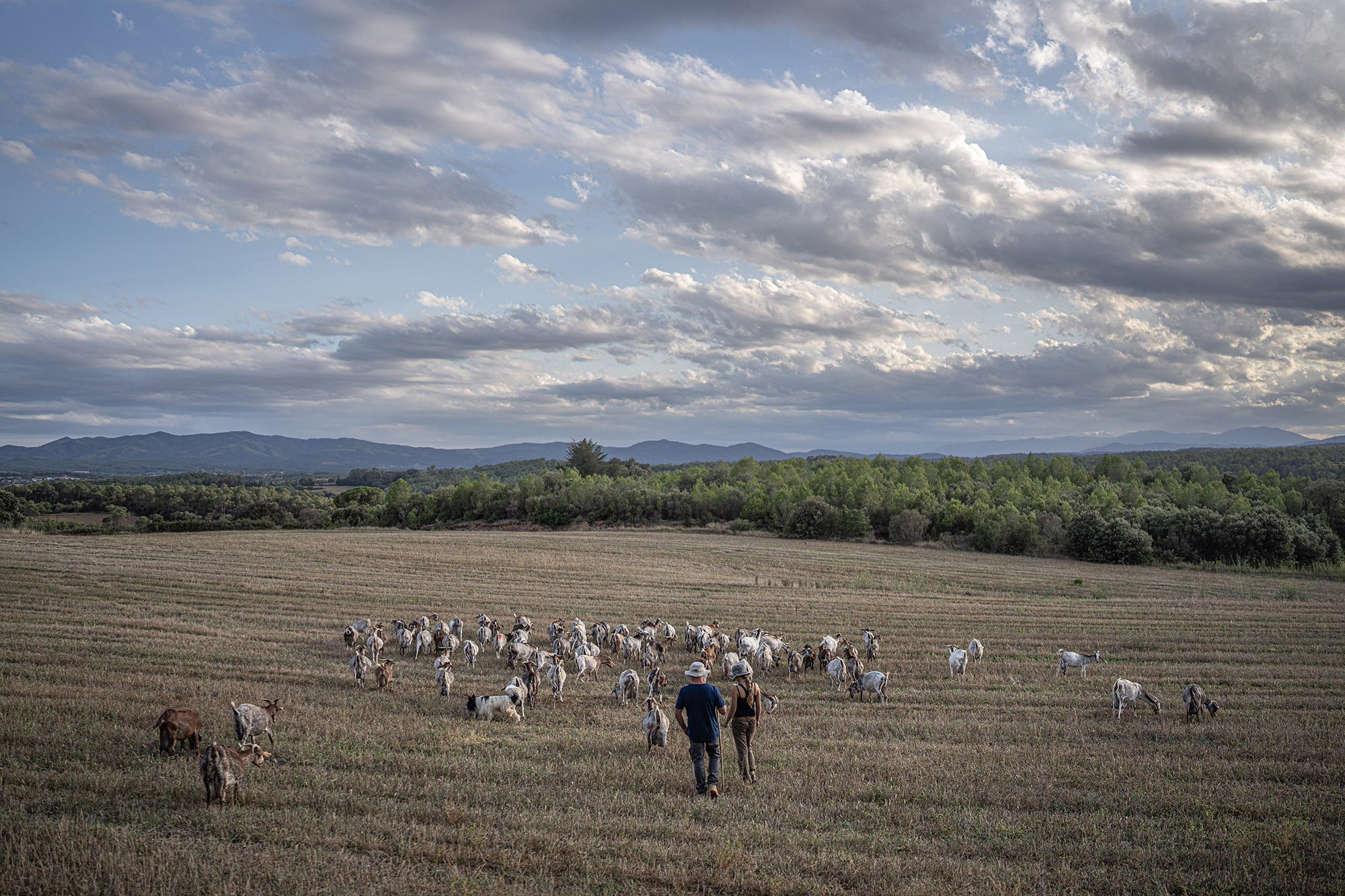
Joan Martí Quer, Judit Nadal’s husband, herds their goats around the community of Gaüses, in the province of Girona. © Pablo Tosco for Probe International
CREDITS
Director: Mikel Konate | Text: Lily Mayers | Photography: Paulo Nunes dos Santos & Pablo Tosco | Video: Mikel Konate & Pablo Tosco | Illustration: Jorge Mileto | Text edit: Maribel Izcue | Graphic edit: Santi Palacios | Social media: Julia Cussó | Web development: Full Circle | Translation: Dixit and Sonda Internacional | Production: Sonda International

How did we execute this story?
To compile this report, a team from Sonda Internacional visited different solution projects in Spain and Portugal in late 2023 and early 2024. To understand the scope of this story they conducted more than a dozen interviews with fire technicians, forestry engineers, firefighters, shepherds and local residents.
Sonda Internacional would like to thank the many entities who took the time to show us their work and tour their projects on-site.
Mega Fires: Beyond Extinction
This report forms part of the larger Mega Fires: Beyond Extinction project, a major undertaking only possible thanks to the collaboration of experts and, above all, the community of members who support us in making visual journalism on the climate crisis.
You can see other chapters within the report and watch our Conversaciones series bringing together firefighting, forest engineers, and climate experts here.
The project is well underway, but we need more help to complete it. You can become a monthly or annual member (or make a one-time donation) here.


